One of my readers asked me if I know how to make the little snack called “karipap” that she had eaten in Thailand. And If I did know them, what type of curry paste they used in the filling and also how to make the flaky circular puff pastry dough. Pretty much asking me for the recipe of this snack.
Of course I do know the little “karipap”. I ate plenty of them and even participated in stuffing them many, many times before in my childhood, but the recipe, ahem…errrr…not really. Someone else–my relatives, my aunt, my grandma, my friend’s mother or one of those “adults”–would make the dough and the filling, then I would just sit down to perform the fun part, wrapping the dough around the filling and waiting for the finished wrapped snacks to be fried so I can eat them.
I had to dig around, make some phone calls, and nearly had to strangle my relatives for the recipe. Luckily, there is an ocean on one side and another ocean and about two continents on the other side to separate me from them, so they managed to keep themselves alive! I finally got the recipe.
This is the first time I made them all by myself, so, there will be a second post in the future. I can’t say when yet, but you will get another one when I perfect it to the point that no further improvement can be made.
This little curry puff is a very popular snack in Thailand, Malaysia and Singapore. The official name in Thailand and Malaysia is “Karipap”, spelled กะหรี่ปั๊บ in Thai. Malaysians also have a different name, Epok-Epok, which is well understood in Singapore as well. I had no idea about the existence of this pastry in other country until I posted the pictures of the prepared curry puffs on my Facebook page before frying them, and a Chinese friend commented on it and said she knows this snack too, but I think she meant gali-jiao, the other Chinese baked puff pastry without the spiral layer crust.
Someone who’s never heard of this little snack before must be furious now. What the heck is it, already? It is a deep-fried pocket of pastry stuffed with savory ingredients, including spices and meat. The most popular filling is chicken with potato, flavored with curry powder, but it’s not limited to just chicken. Beef is also a popular filling choice as well.
The character of the dough is quite special too. It’s called a “Spiral Curry Puff”. The spiral is applied to the appearance of the dough that has several layers of paper-thin dough stacked up in a spiral shape, resulting from the way we laminated the dough that you will learn from this post.
I tried my best to find a history of this little snack to fill my own little brain cells and for your knowledge as well. I failed, since it is eaten primarily in three countries. (Note: I only count the countries that make these puffs with the spiral pastry dough and not the ones with the smooth dough or even the ones that bake the pastry instead of frying, because in that case I would have to include all the South American countries that make empanadas, too!) I googled all three names in English and got multiple results.
Summaries of all researches: One said it had British influence, of which I disagree. I’ve never seen British transporting layered or laminated dough as they colonized the planet. Not only that, Malaysia could not have been the only country that adopted these laminated doughs, right? The Brits were all over the globe at some point. Why didn’t other countries inherit this circular dough?
One said it is from Portuguese influence. This is slightly closer than Brit, but I still disagree. This is a FRIED dough, not a baked dough. The empanada idea cannot be discounted in this case, but I still don’t see a trace of the circular layered dough there.
One said it has Indian influence, with the proof of the samosa as the instigator. I don’t discount that as well. True, samosas have almost the same filling (minus the meat part) as this karipap, but the shape and the dough isn’t the same.
I have my own theory. I think Asians for some reason like to label the “influencer” as the Westerner first and forget to look in their own region. I think this curry puff resulted from a combination of Chinese influence and Indian influence.
Why do I think the Chinese have a part in this? The circular dough, if you really look into the way it is layered, is very similar to the Chinese bean cake’s layered dough. They don’t use pure butter to separate the layers of the dough like the French, but they use flour mixed with lard as the “layer separator”. How clever. It’s also much easier to roll the dough in the hot climate too.
Another proof is the way they layer in a circular tube instead of rolling a big sheet in layers like the mille-feuille or other normal pastry. This is very typical of the Chinese, who are much more efficient. Why bother rolling the whole sheet when you still have to cut it later into small pieces to use it, right?
The filling definitely has Indian influence, with the curry powder and potato in the mix. I’m not going to argue with that. The southern part of the Malay Peninsula was the melting pot in the olden time because it was the port for vast trading and the docking place for ships heading back and forth from Europe, and India to China and vice versa. It makes sense to assume that the spiral curry puff has been born of multi-cultured influence.
If my assumption is wrong, please, send me more proof. I’m open to all the facts beyond what I could find.
In the meantime, let’s make the karipap.
I used a chicken filling because this it the most popular and most well-known filling. You can substitute the chicken with ground beef or come up with your own filling once you know what to expect. I also make some with shrimp, or purple yam, or taro root too. The sky is the limit when it comes to the savory filling of the Asian dumpling.
Ingredients for the filling
Chicken meat, cut in cubes about 1/2” size, 1-1/2 cups
Onion, diced 1 cup (or one small onion)
Cooked potatoes, cut in cubes, 3/4 – 1 cup (or one medium potato)
Curry powder 1 – 1–1/2 tablespoons
Salt 2 teaspoons
Sugar 3 – 4 tablespoons
Butter or oil to stir fry 2 – 4 tablespoons (depending on the type of pan or wok you will be using. I used 2 tablespoons for a non-stick wok)
(Optional) Ground white pepper 1/2 – 1 teaspoon
(Optional) Thai Trio, garlic, cilantro root and white pepper, mixed 1 teaspoon
(Optional) Maggi or other seasoning sauce 1 tablespoon
(Optional for chili lovers) Ground paprika 1 teaspoon
Method for the filling
1) I cooked the potato in the microwave. Cut along the length and cook on one side first for 2 minutes then turn and cut the other side (to release the steam and prevent the potato bomb in the microwave) along the length again and cook for another 2 minutes. This makes it easy to peel. Cube it and you should be ready to stir-fry the filling.
2) Cut and prep everything before you even think about taking your wok or pan out.
3) Put oil or butter in the wok at medium heat and start with the Thai-trio and onion.
Cook the onions until nearly transparent.
4) Add the chicken, half of the curry powder and half of the seasoning (salt, seasoning sauce and sugar, but keep the paprika and the pepper aside for now)
stir fry them until the chicken is done, or at least 85% done. You will continue cooking it in many steps.
5) Add the potato and the rest of the seasoning, including the paprika (if you are using it; I don’t, as you might already know),
stir fry until they’re all mixed well. Let the potato absorb the liquid, which is the duty of the potato here.
The content has to be dry or the dough will get soggy.
6) Taste-test it and adjust to your preference. If you follow my ingredients exactly, it may seem borderline too salty–don’t worry, we will have the dough wrapped on the outside and everything will be fine at the end.
7) Turn off the heat and stir the white pepper in. Then you leave it to cool while you are preparing the dough.
The dough
This is a laminated dough.
What is laminated dough?
It is a dough that is stacked in multi-layering. The method is to layer the dough alternating with fat–either butter or oil–so each layer won’t stick back together again. You don’t do it one layer at time. It’s not that smart to do it that way. You start with two layers, sandwiching a layer of fat in the middle then roll the whole thing flat, which of course makes it longer. Then you fold. From two layers, one fold will give you four layers, right? Two folds will give six layers.
They you roll it out again because after the first fold, you dough get too short and too thick to fold again. After another roll, from six layers one fold you will get twelve, two folds you will get eighteen layers. Do you get the idea? Normally you will do one more roll and this time you will get many, many more layers, about 18 times 3, at the least. You get 54 layers. If you want more one more fold you will get over hundred layers, if the dough allows you to.
This is the mysterious “mille-feuilles” secret. Do you know that the dough of the mille-feuilles would be folded six rounds, with three folds in each round. (No, I never been able to do the whole six, my dough was fighting furiously at round four, so I never got more than 200 layers 🙁 but I will someday. (Someone else claimed that over two thousand layers has already been done—come on!)
The method is not that much different between the French and the Chinese way, except that the French roll and fold a rectangular sheet of dough. Let’s see how the Chinese would do it.
There will be the main dough. In this case I will call it the “water dough”. This is flour mixed with oil, water, salt and sugar. This is the dough that would be eaten after frying. It will be the “outside” dough at the start. Then there will be the inner dough, and this is called “the oil dough”. It is just flour and oil mixed. This layer of dough would served as butter in puff pastry or, if you ever made mille-feuille, this will be the same as the butter block mixed with a little bit of flour.
Ingredients for the water dough
All purpose flour 300g
Oil 5 tablespoons
Sugar 2 tablespoons
Salt 1/2 teaspoon
Water 8 – 10 tablespoons
Baking soda 1/2 teaspoon
Ingredients for the oil dough
All purpose 120g
Oil 3 – 5 tablespoons
Method
1) I need to explain why I gave the ingredients in ranges and not exact. It’s depends on how moist your flour would be, and this is not up to you as much as your environment. I used the recipe from Thailand for the water dough and it always too dry; I have to add water every time because California is definitely dryer than Thailand. My friend in Florida has no problem following the recipe from Thailand with the exact same amount of water in her dough.
How about the oil dough? Same problem—it depends on the level of moisture in your flour. So start with the low number first and see if the dough comes out right, then gradually add more water or oil as needed.
Good news, I am developing my own water dough recipe that replaces the oil with egg, and I will give it to you as soon as I can perfect it.
OK…Mix all the ingredients except add water–just 8 tablespoons first–then knead it, then add more water if you need it. Mix until the dough is smooth in your hands. You can use the stand mixer (I do) but do not over-mix, and let the dough rest for at least 30 minutes.
2) Mix the oil dough by using 3 tablespoons of oil first and if the flour won’t become cohesive then add more. I used 4-1/2 tablespoons for mine.
3) After the resting period,
divide both doughs in two or three portions. I divided mine in three but I’m sure two would be ok too. You will get more layers with two.
4) Roll the dough into balls, flatten the water dough balls and put one of the oil doughs inside and wrap it completely. Repeat with the rest of the balls.
5) Roll the dough out flat
and start rolling one side of the dough into a cigar shape. Repeat it with the rest.
6) Now turn the rolled dough so it sit 90 degrees from the edge of the counter.
Roll them all out flat again.
7) Roll them back into a roll again. This time the roll will be so much fatter and much shorter.
8) Prepare to cut the rolled dough in to discs. I expect you to get about 20-22 discs from all of this flour.
9) Roll the disc flat. You can see the circular pattern.
Roll it thinner into an oblong shape.
10) Fill the dough with the filling.
11) Close the dough around the filling.
You can close it with fork, but the traditional way is to twist the edge of the dough the way I do here.
12) Put the finished wrapped dough in a tray and cover so they won’t get dry. Do it until you fill every piece of dough.
13) Put oil in a wok, enough to cover the karipap. Set it over medium heat.
14) Fry the karipap in the medium heat, turning repeatedly so they get even heat until they’re golden brown. If your oil is not hot enough, you will see the pastry start to fall apart.
If the oil is too hot, the karipup will brown on the outside but be wet and sticky on the inside.
15) Eat it with Ajad that I gave you the recipe for long time ago here.

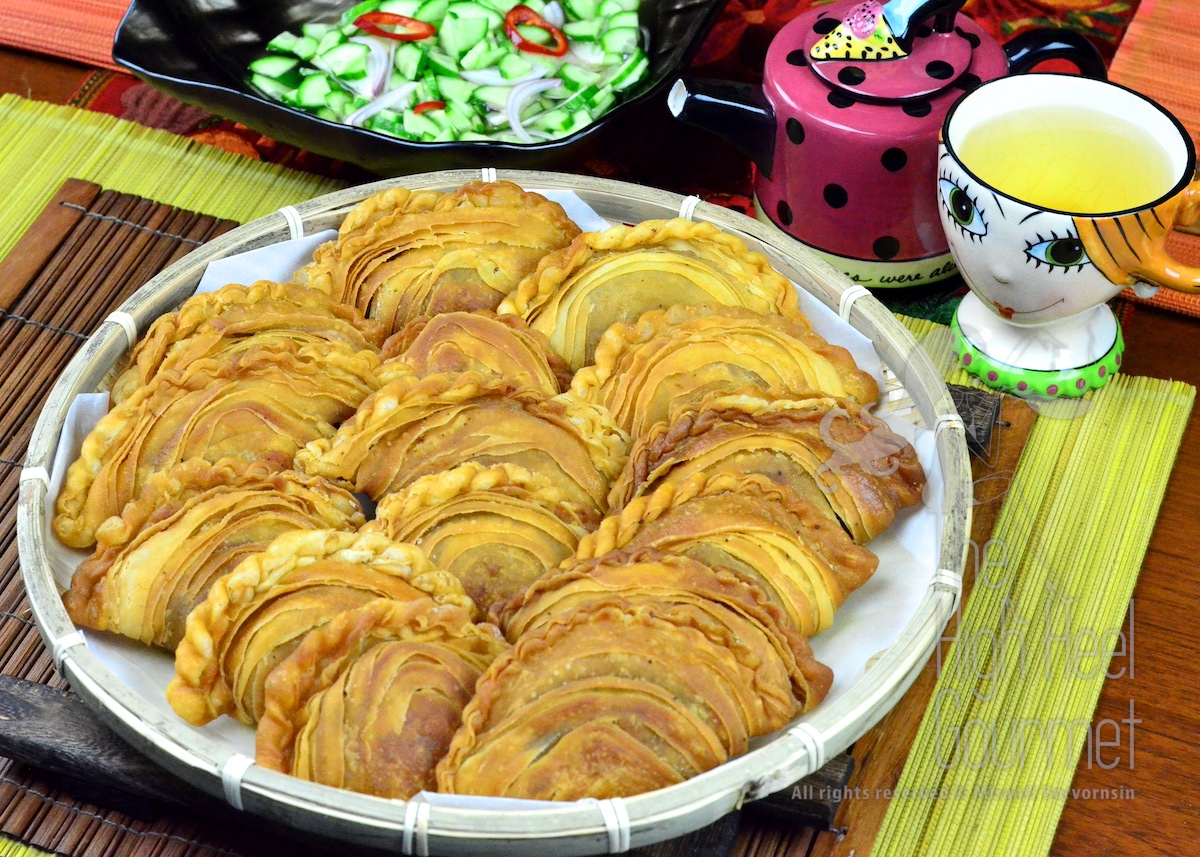
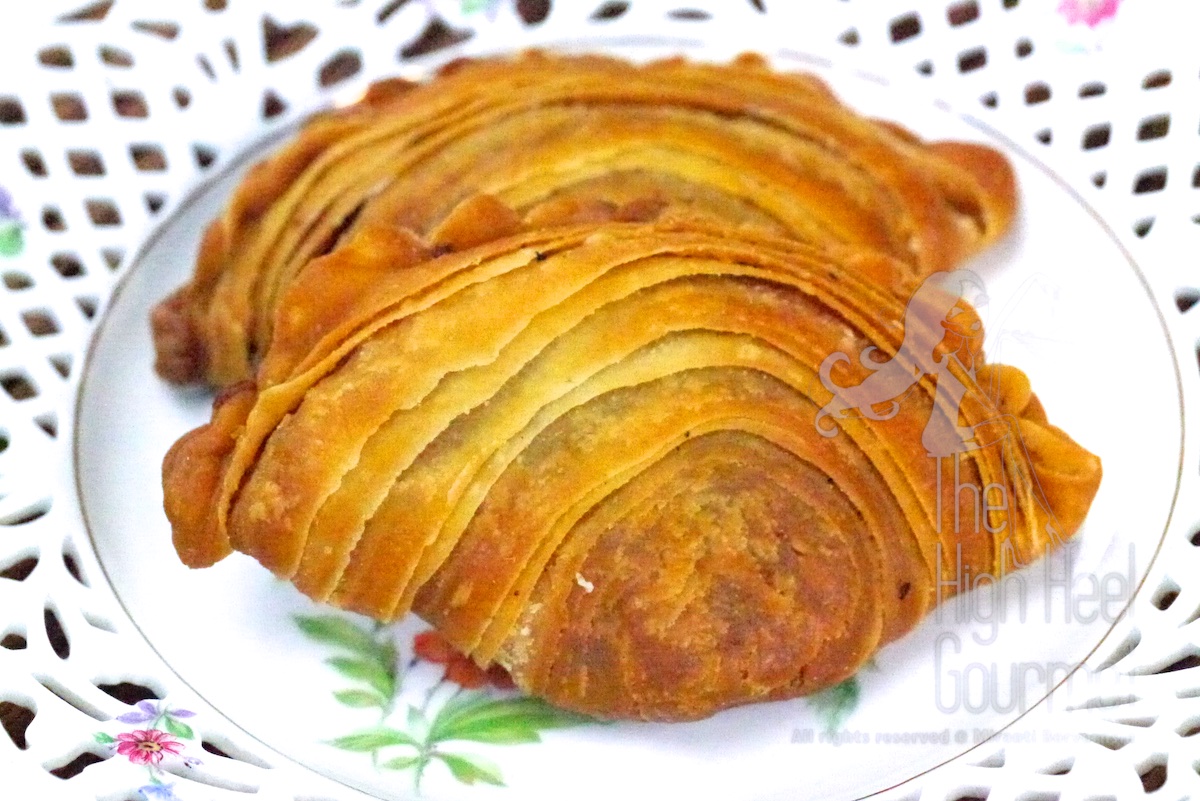
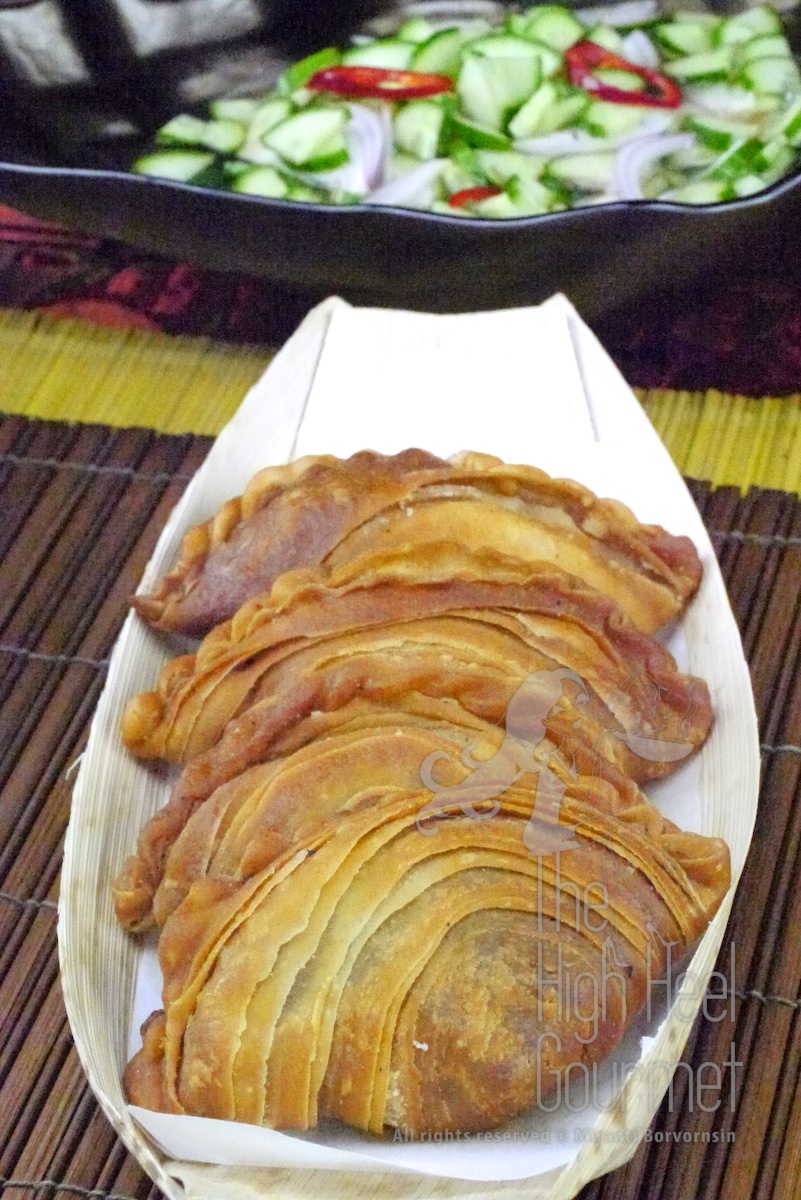
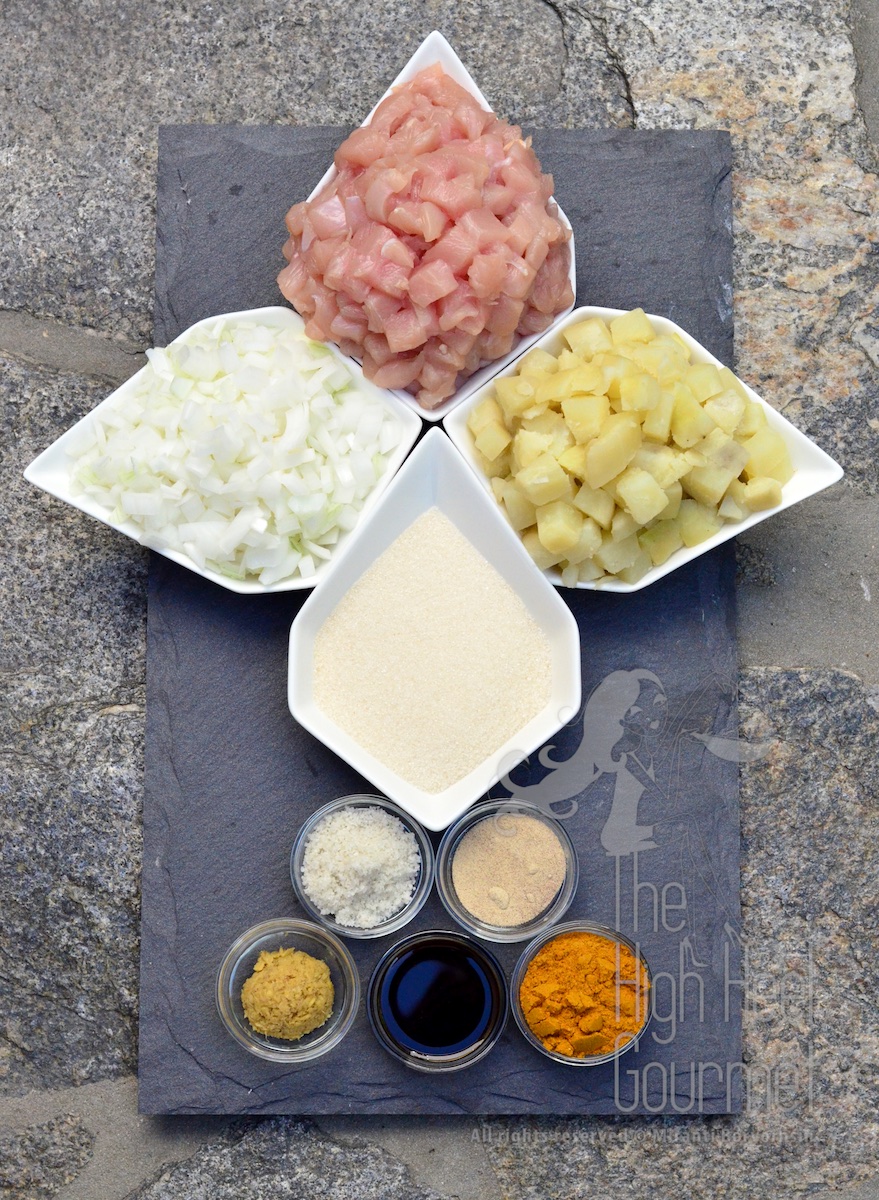
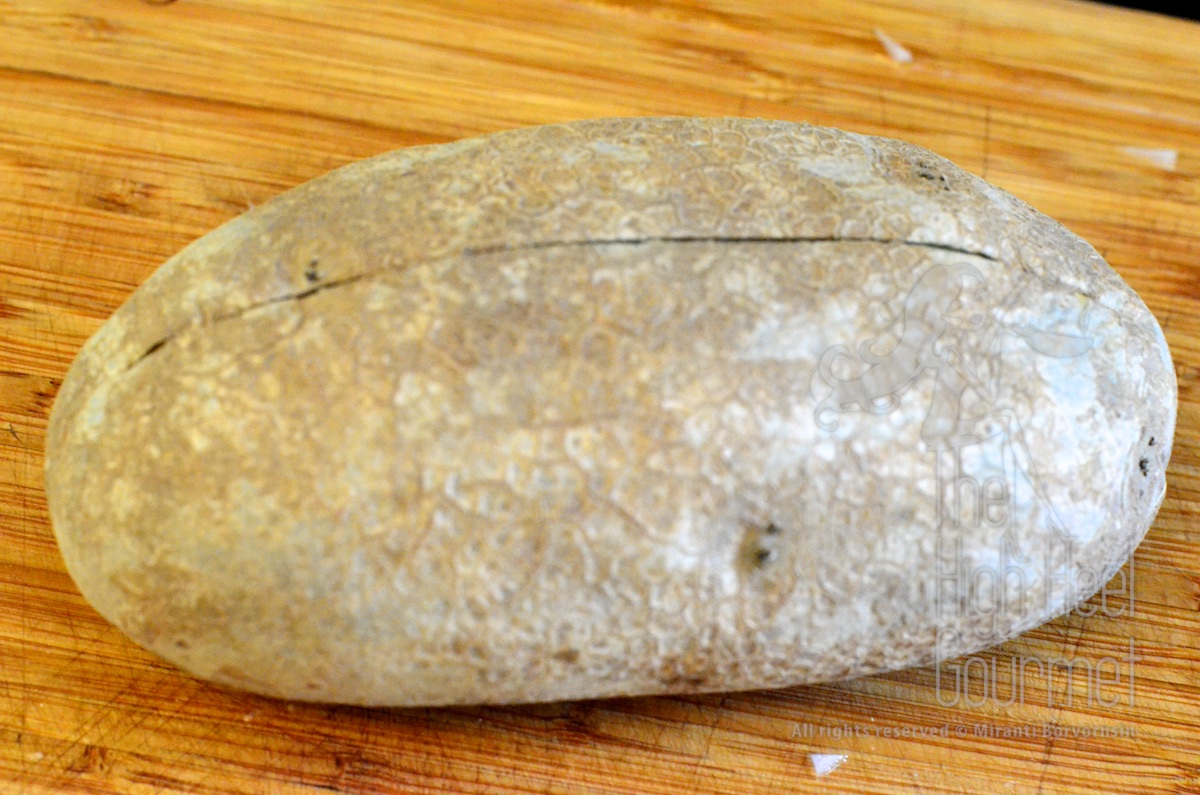
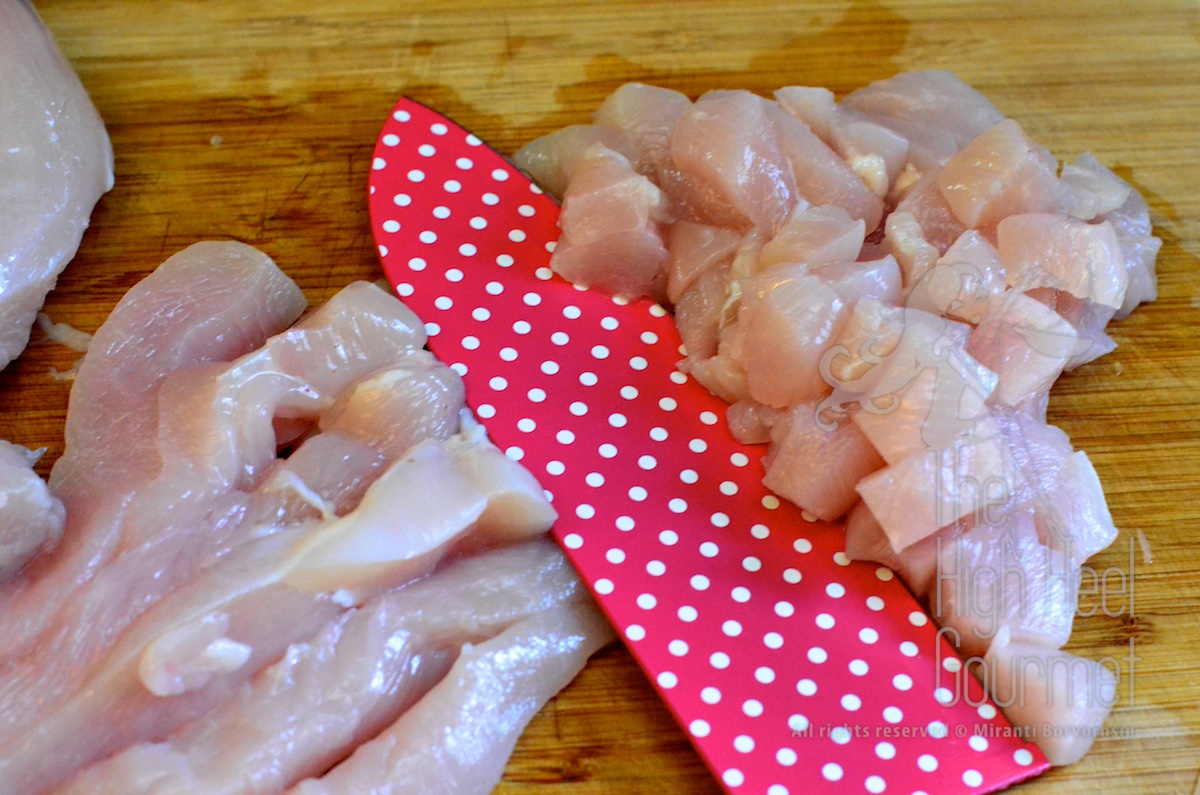
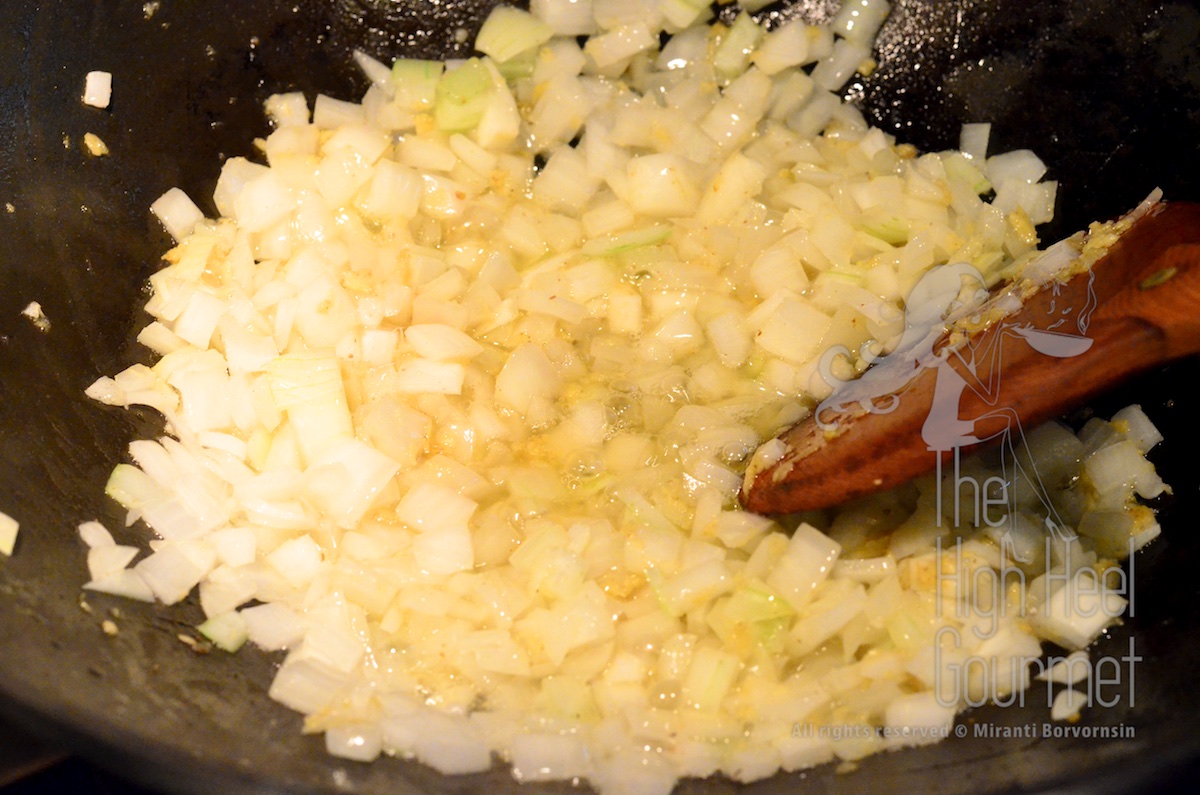
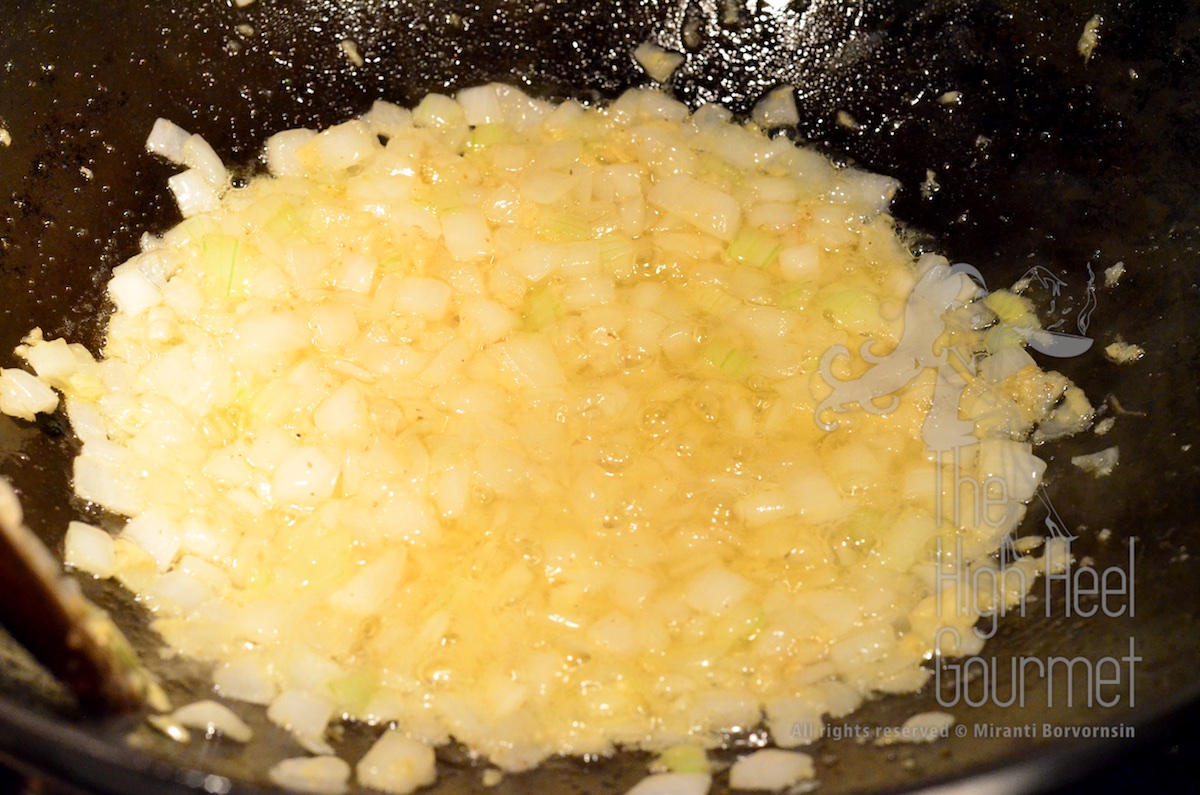
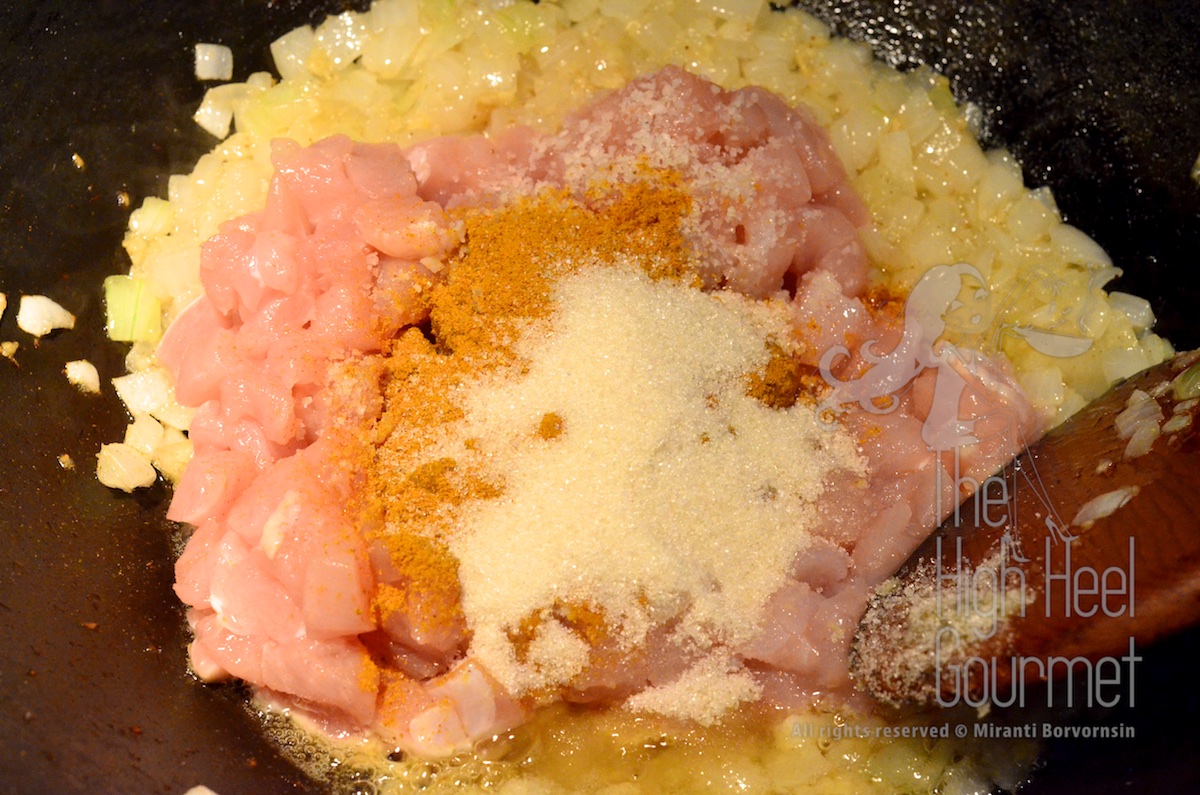
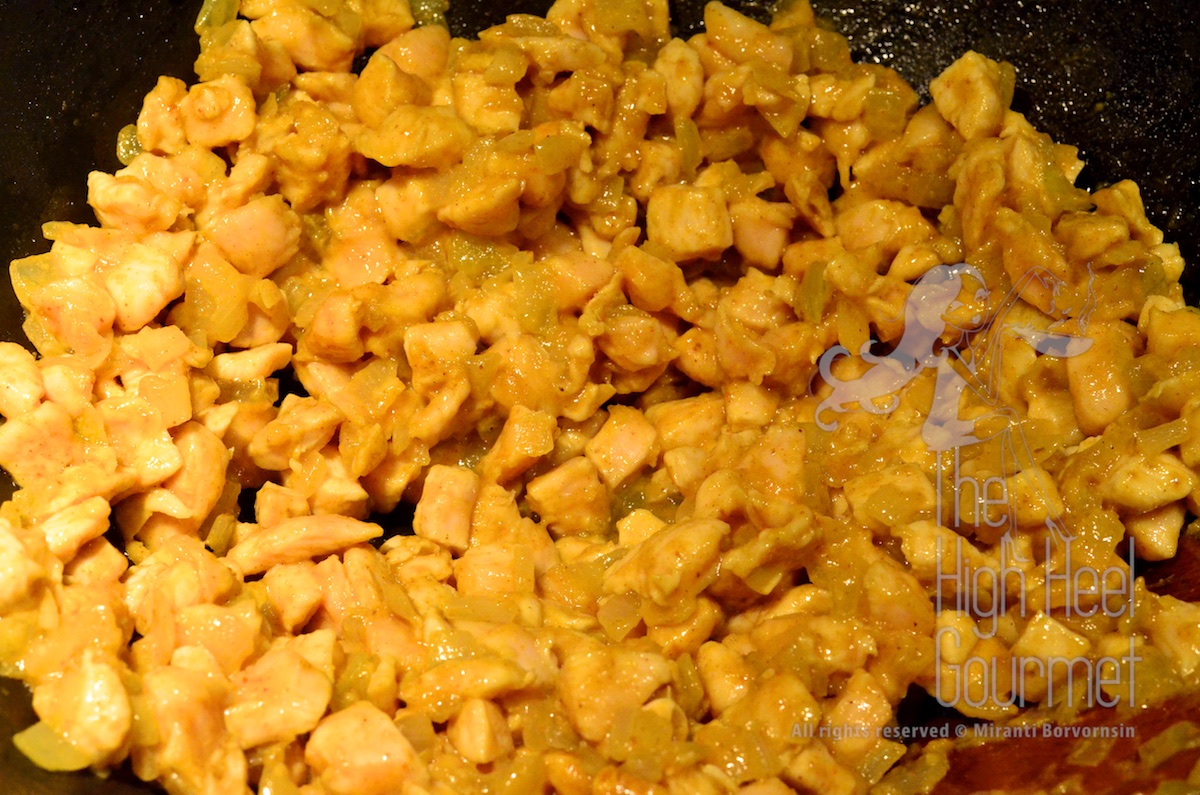
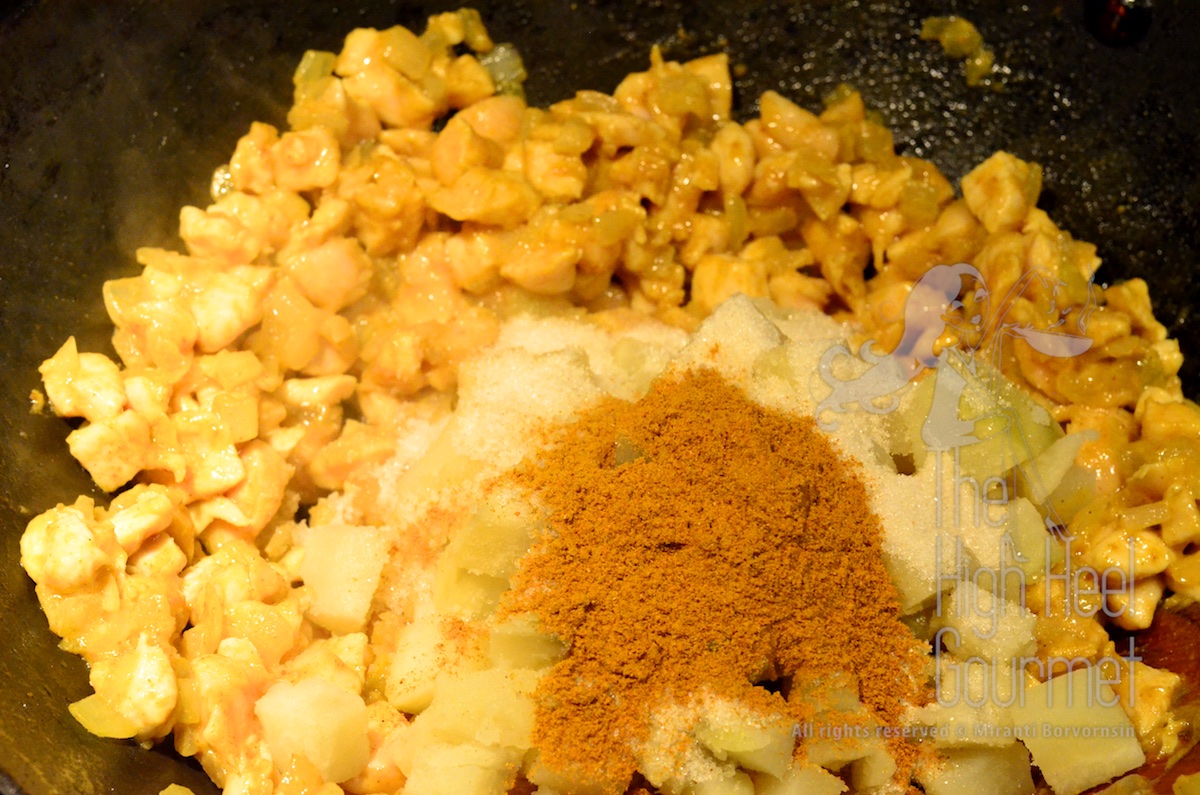
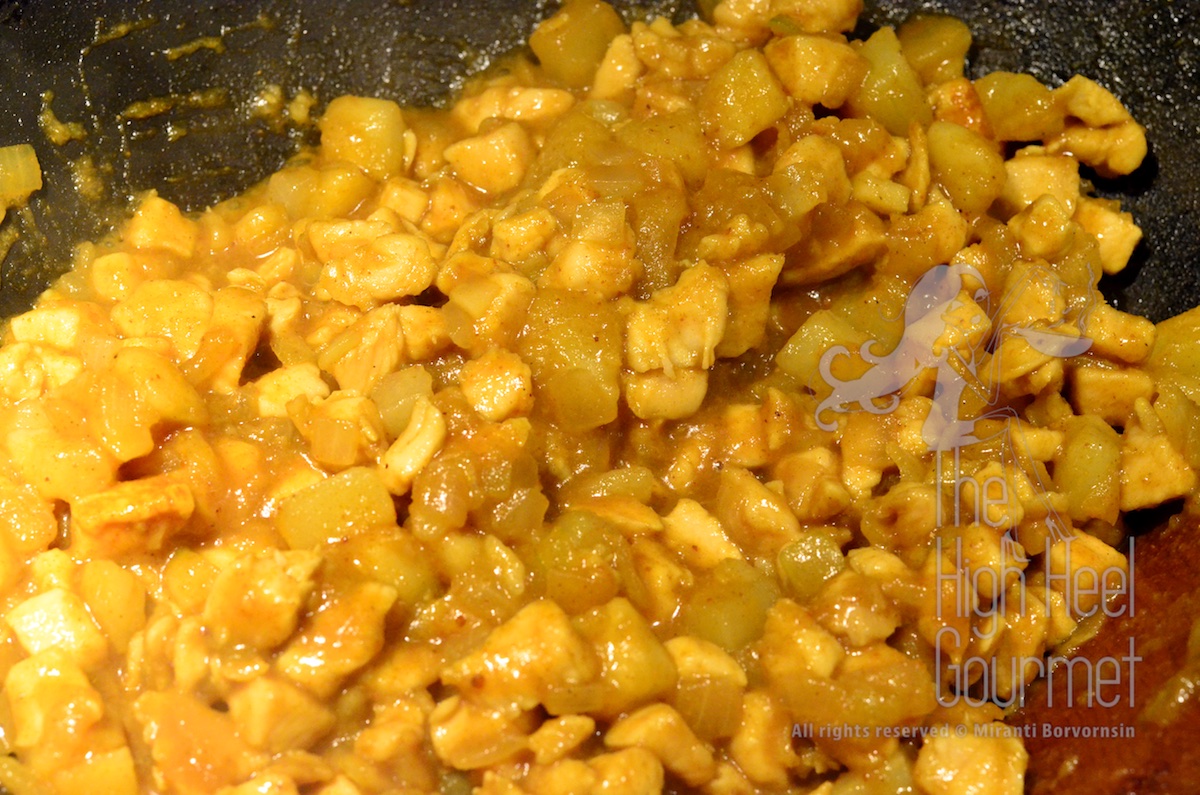
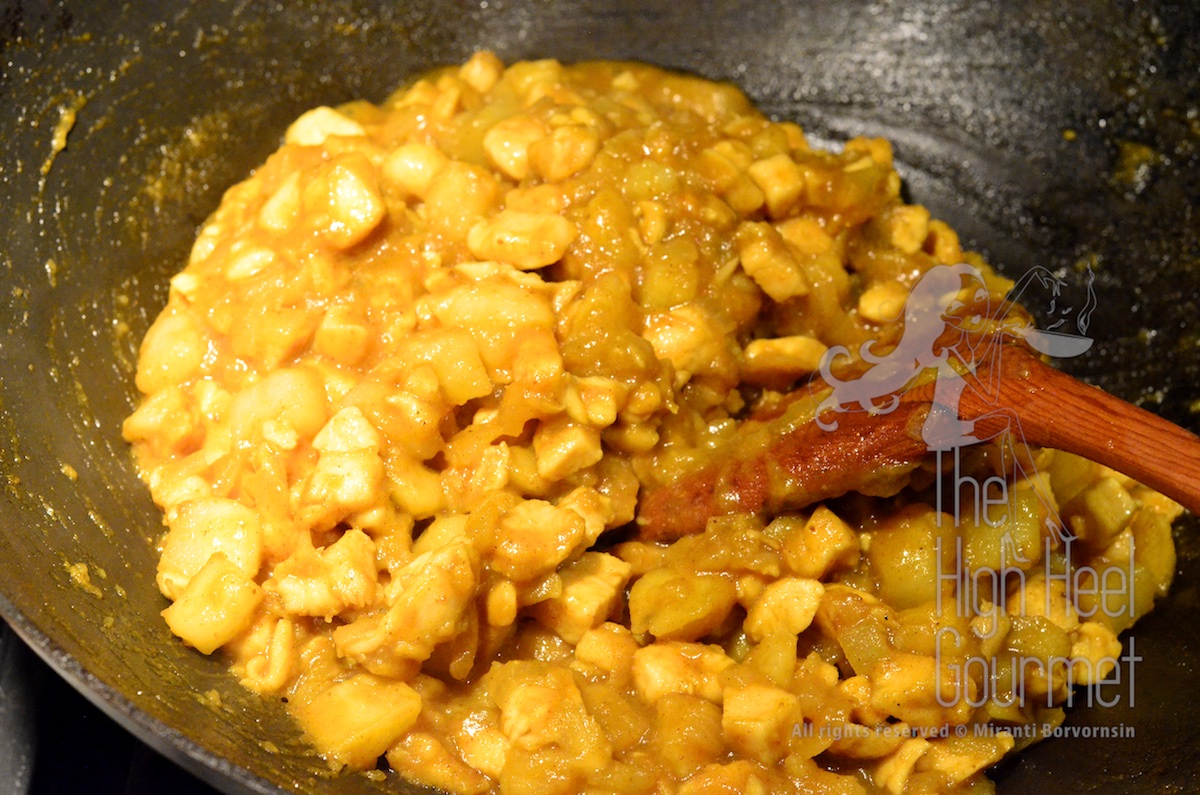
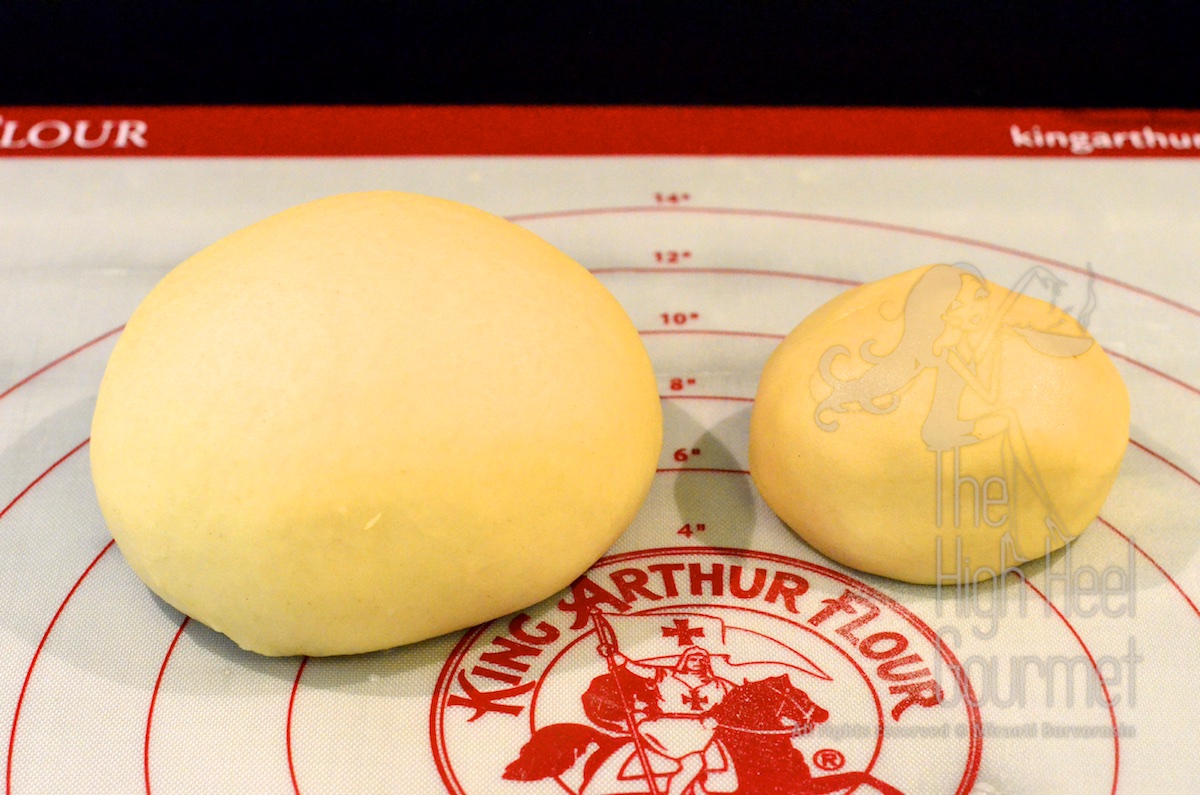
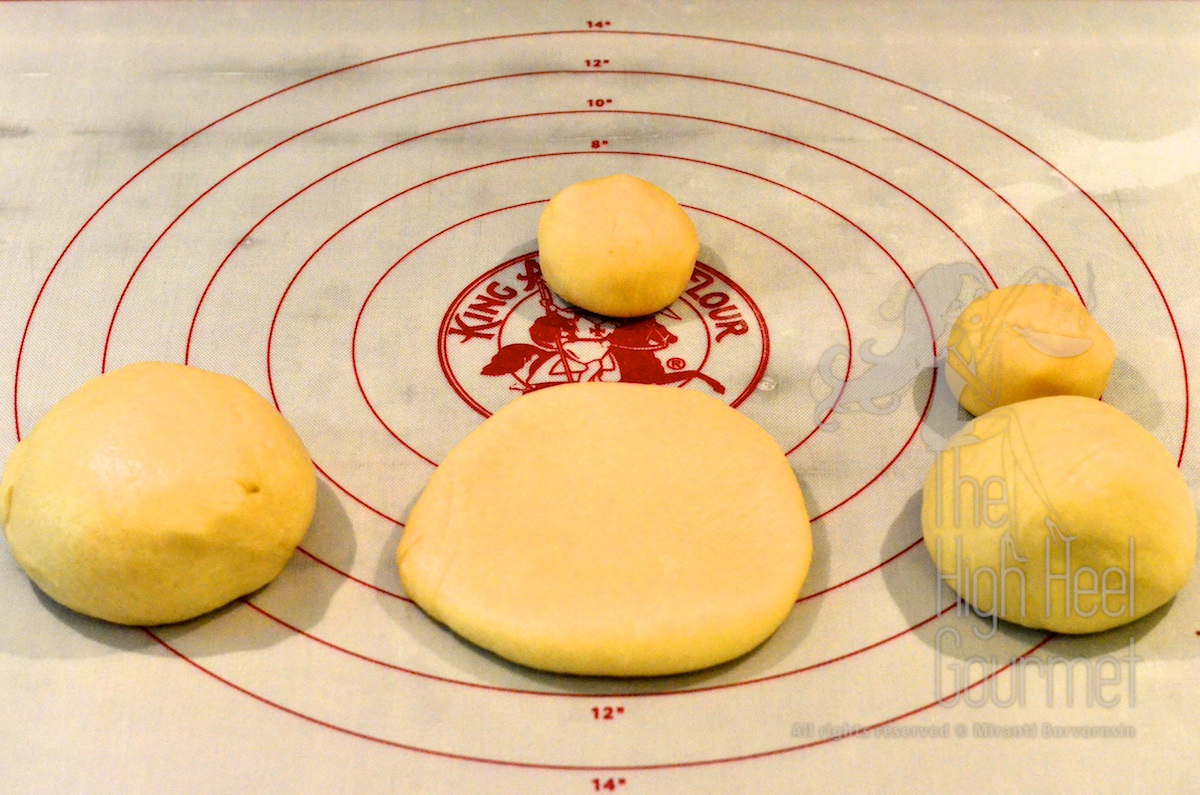
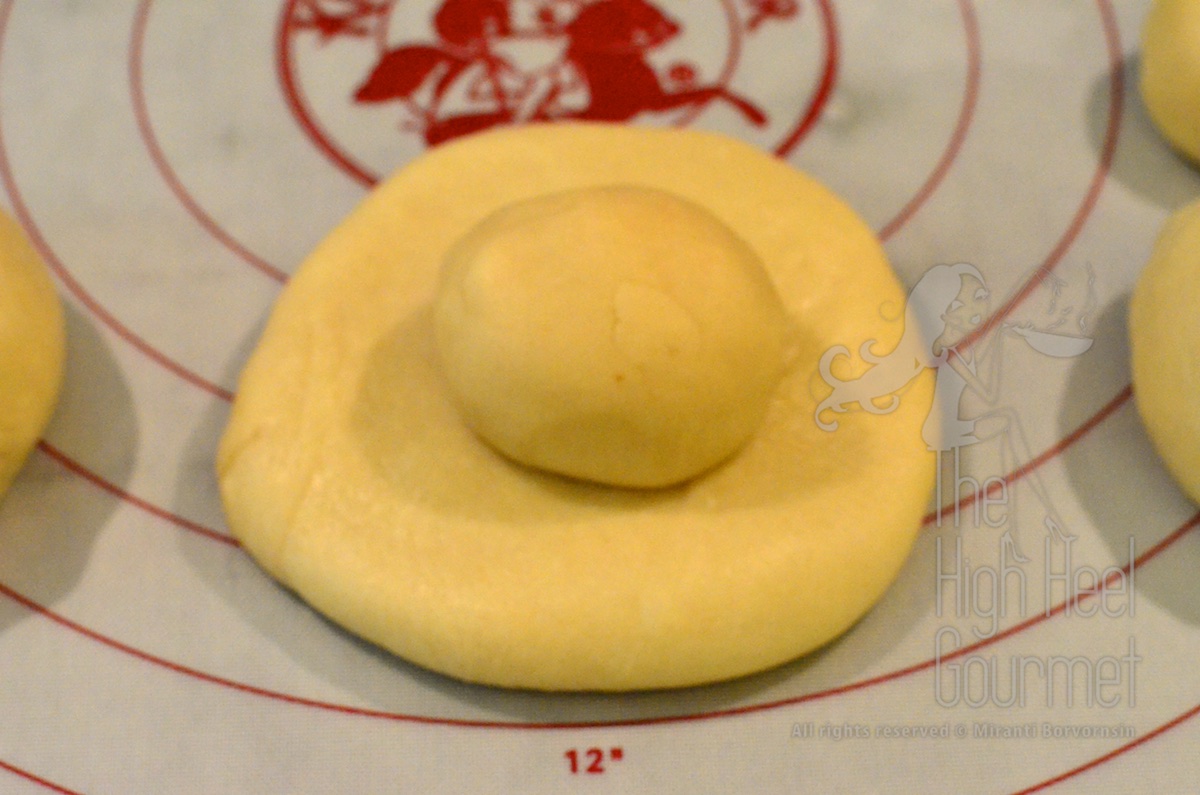
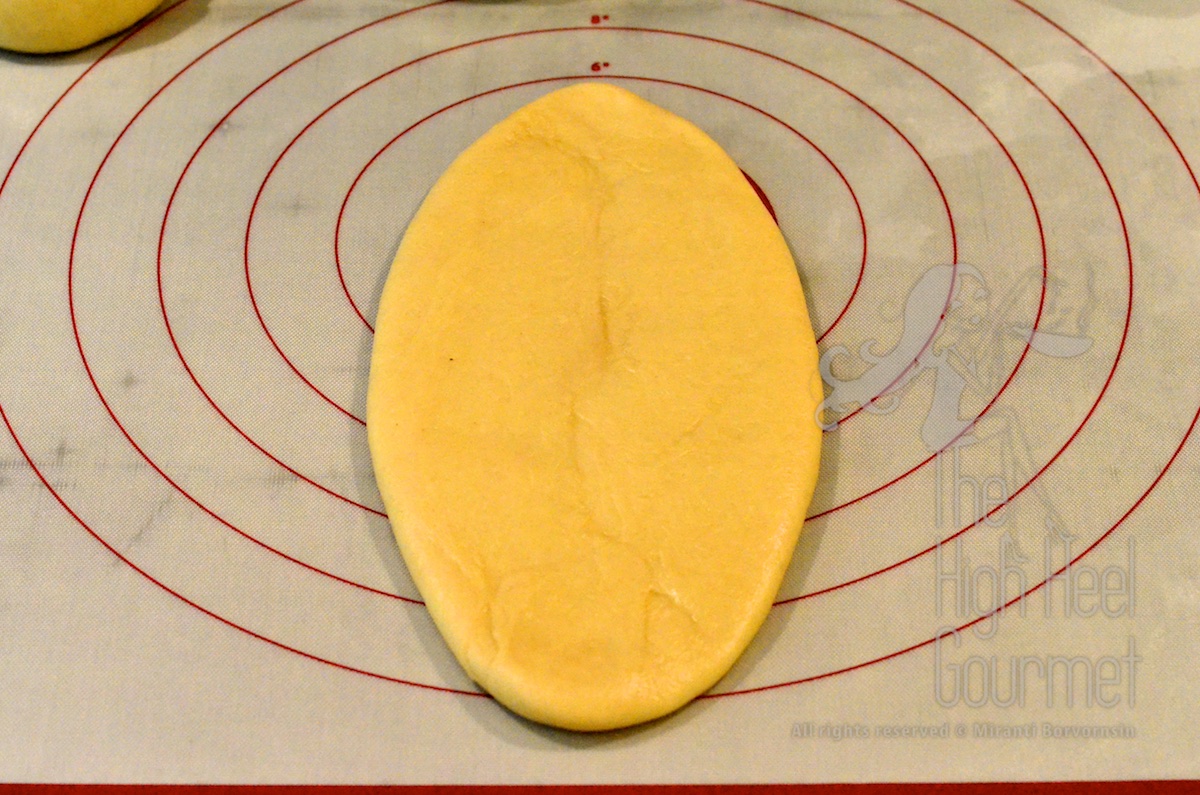
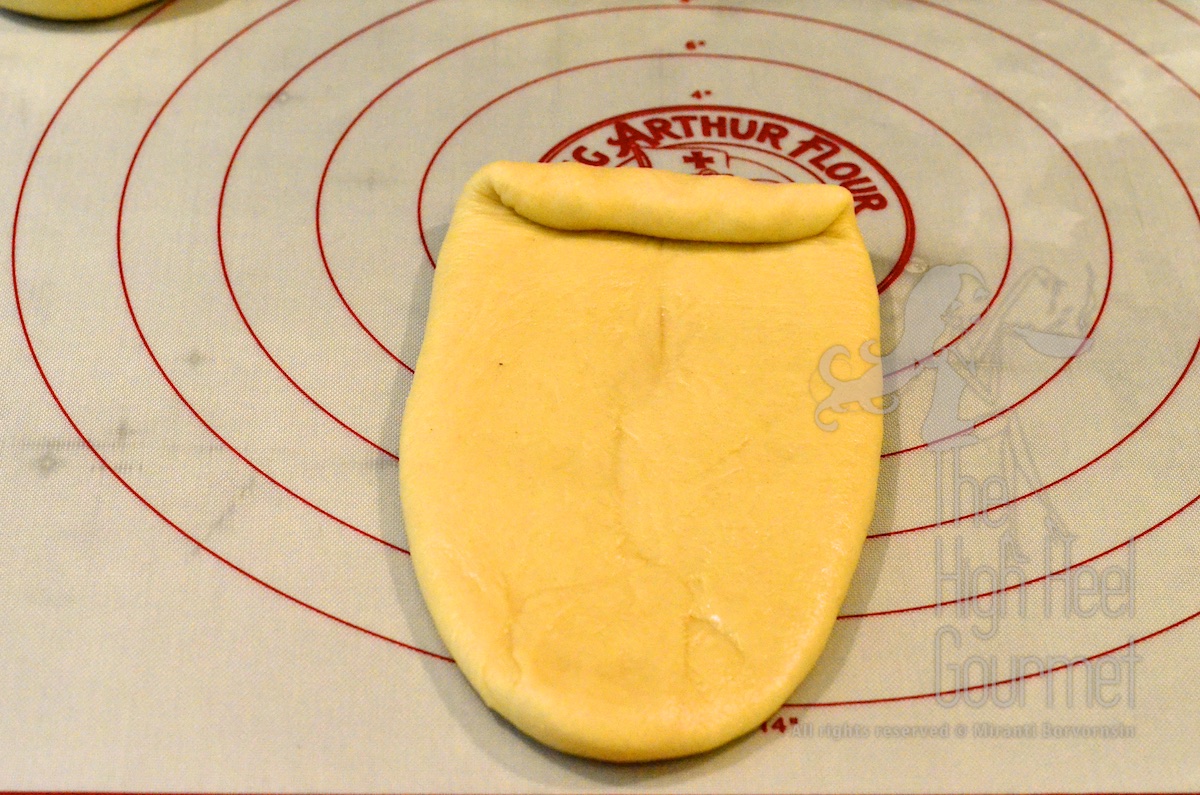
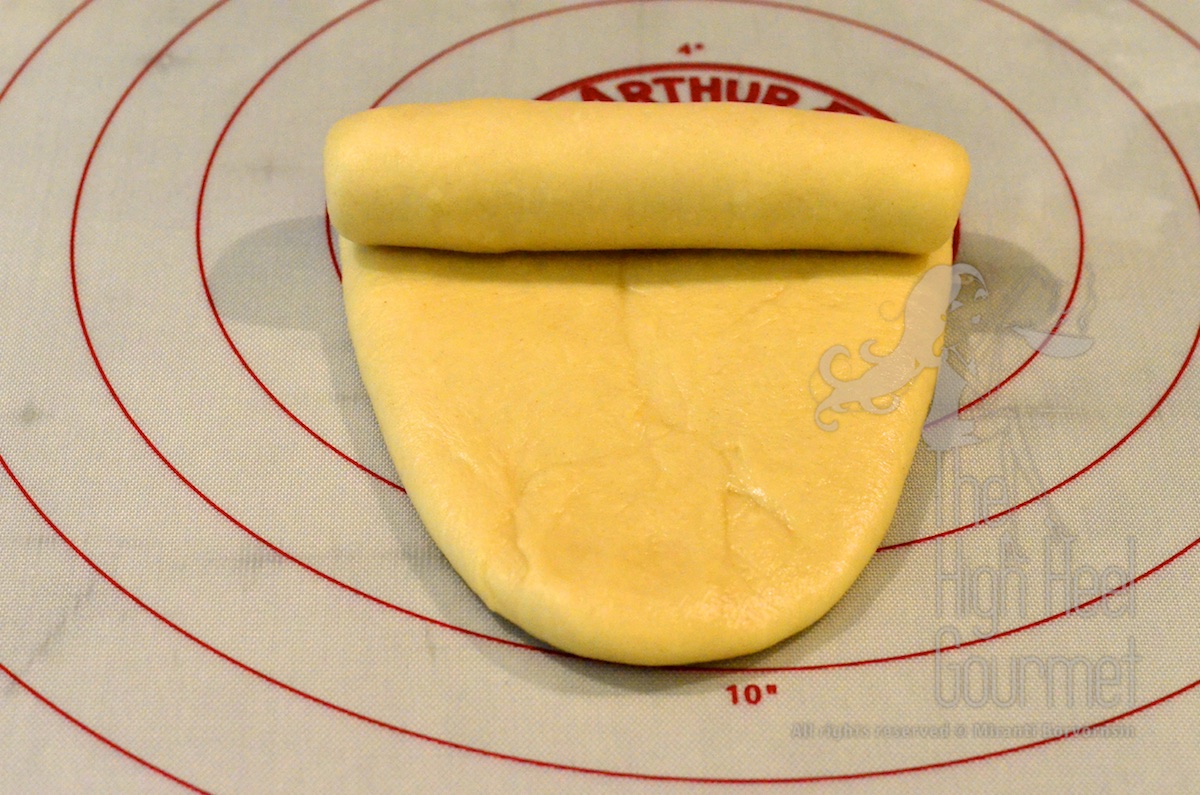
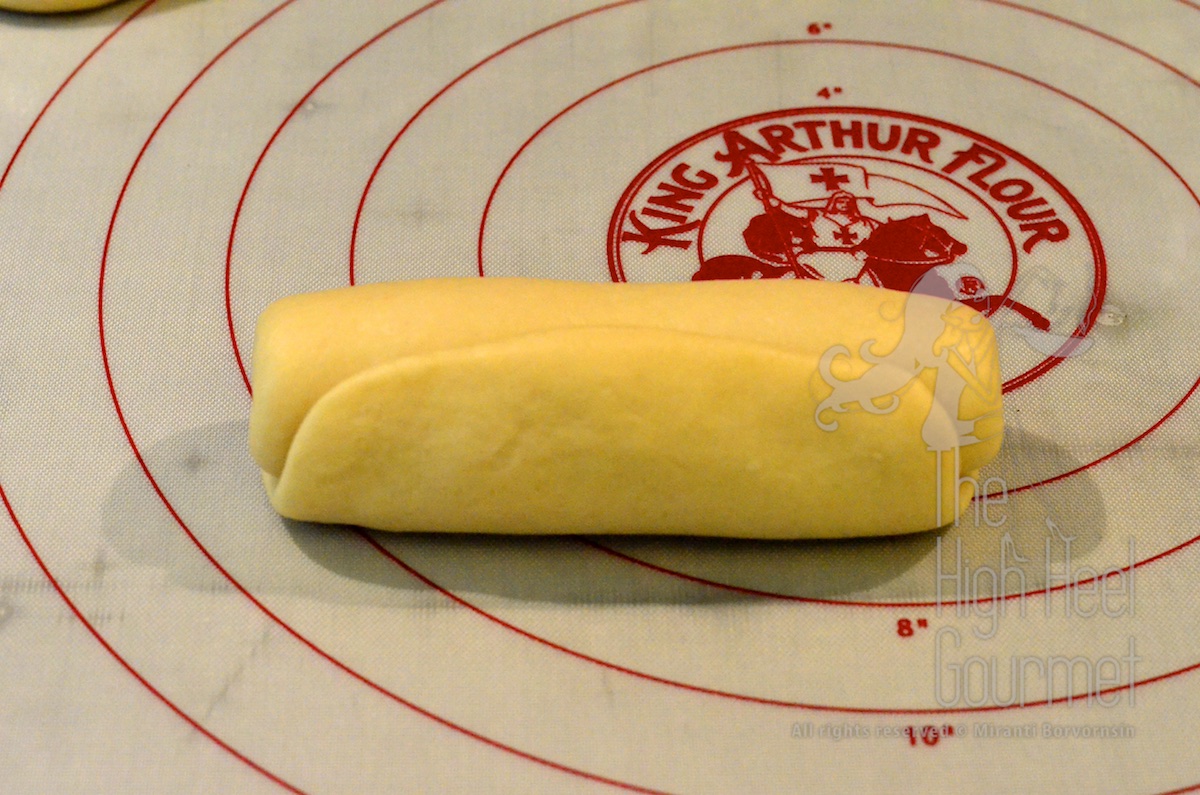
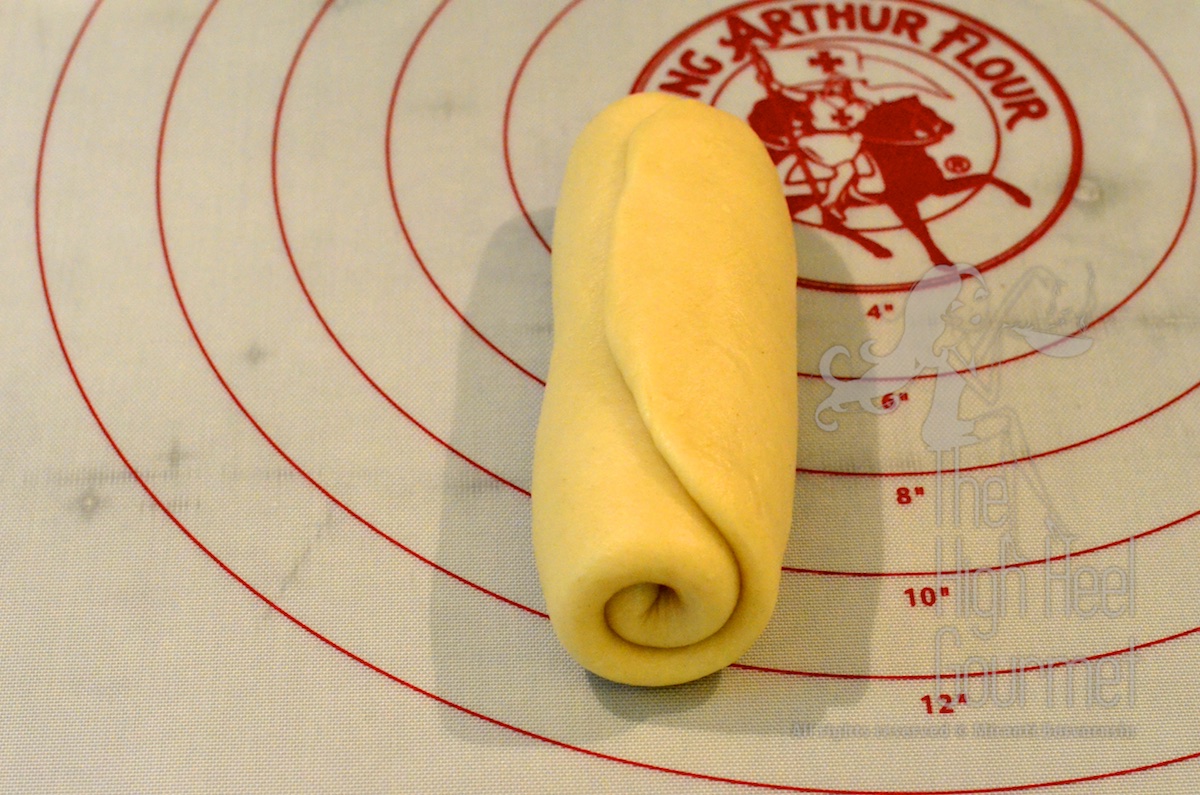
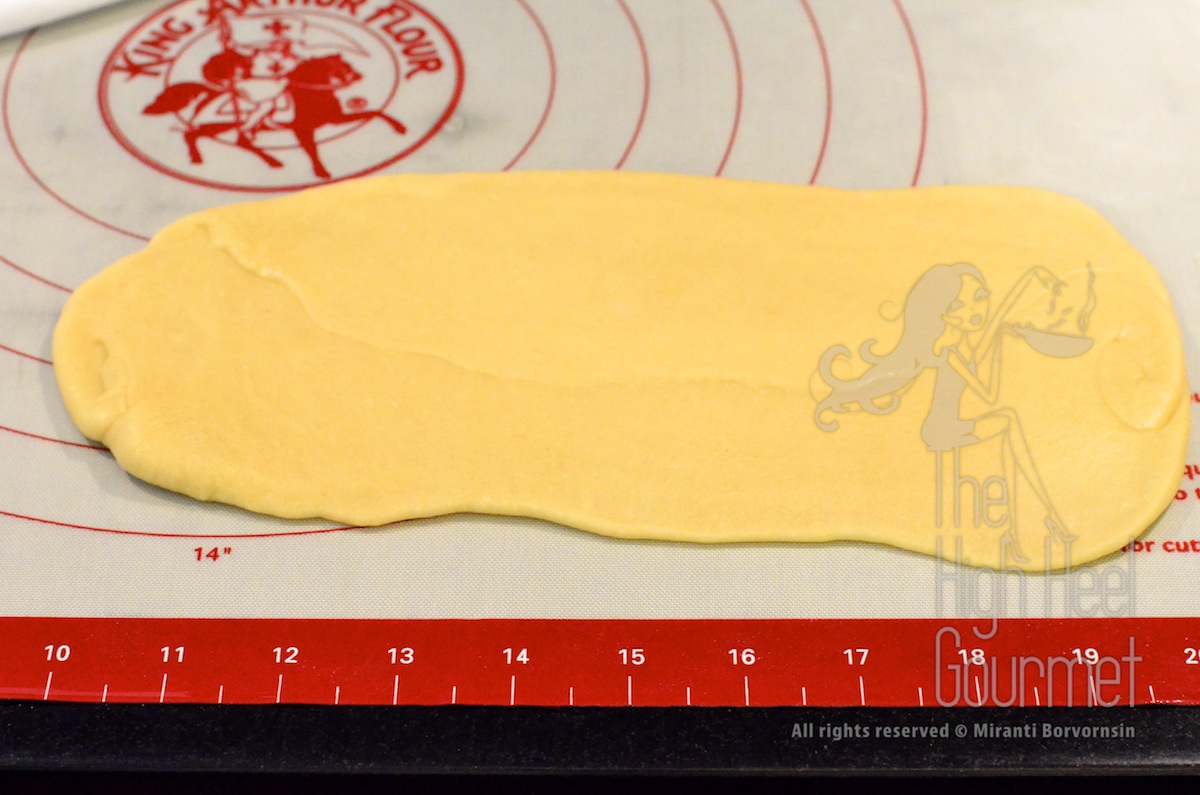
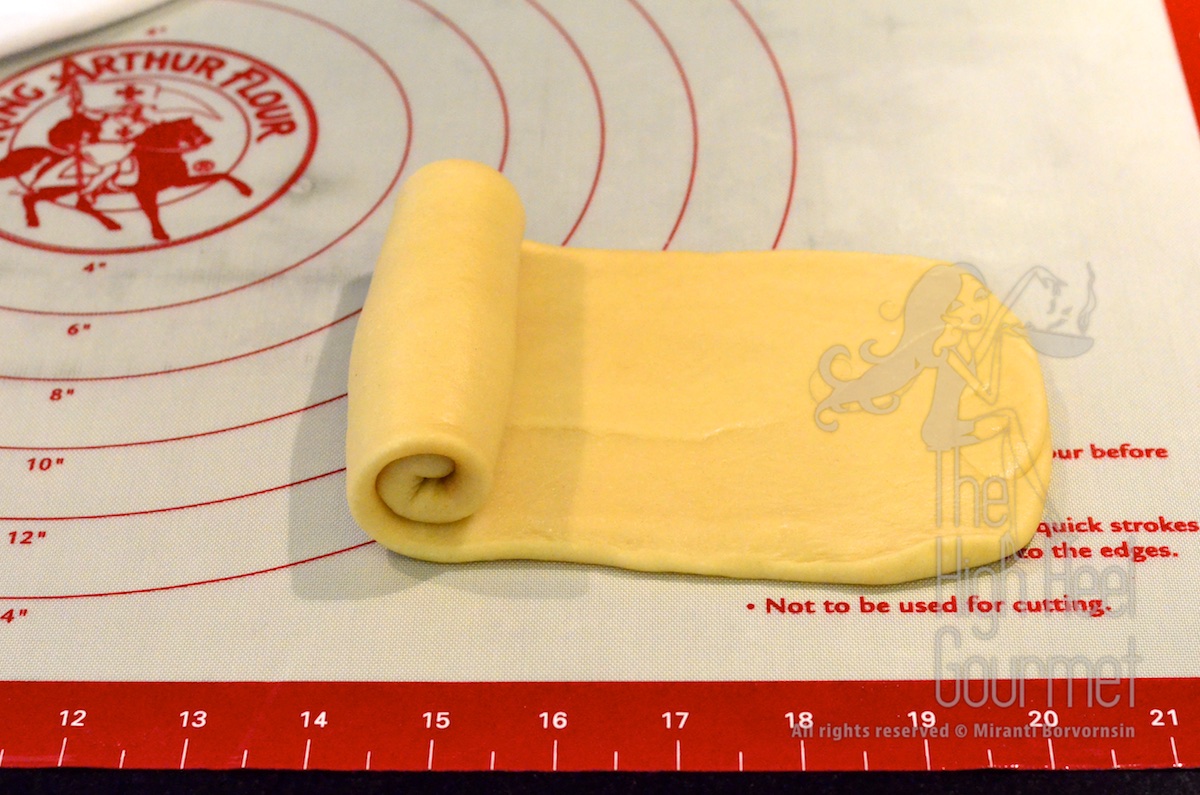
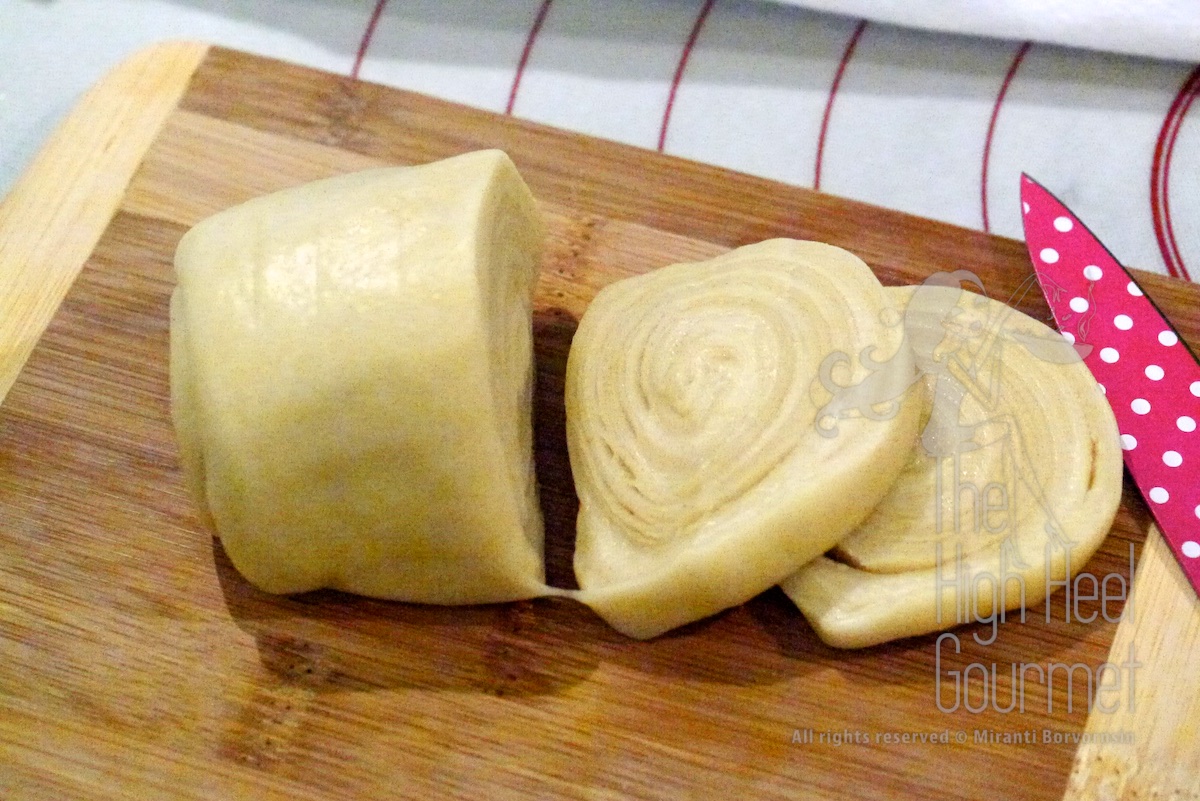
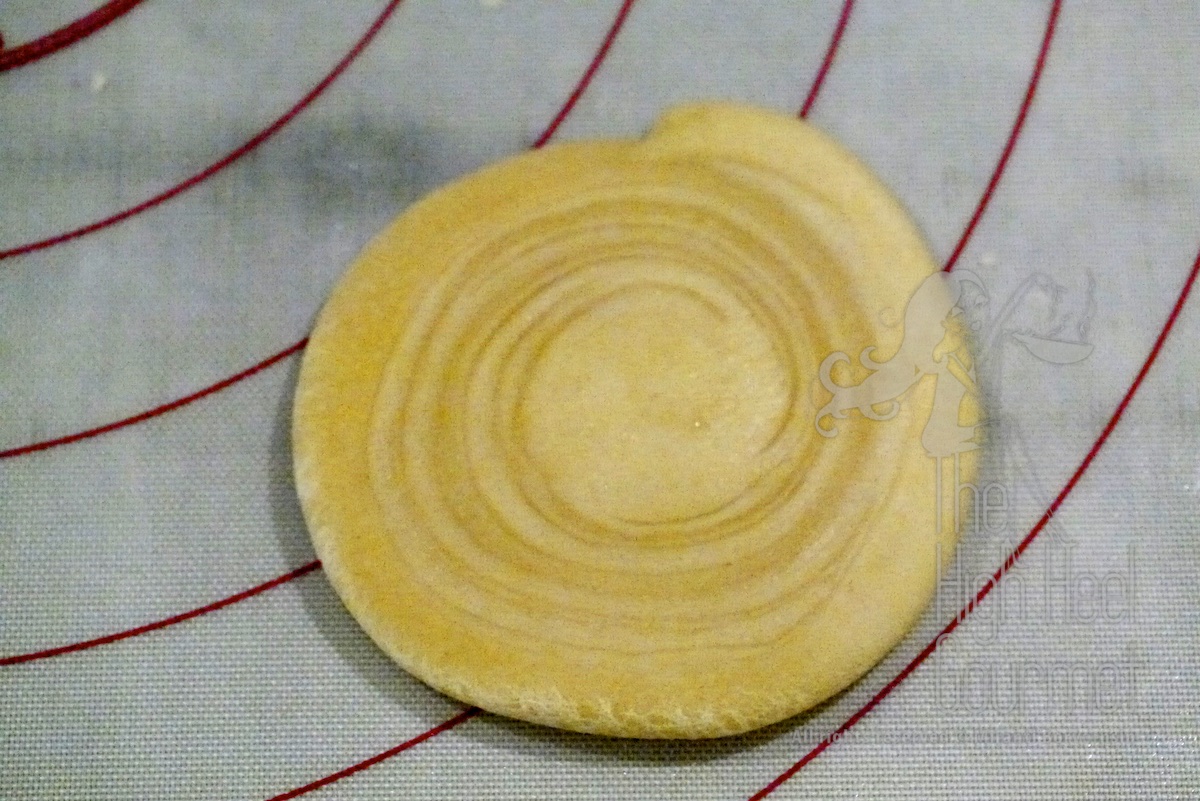
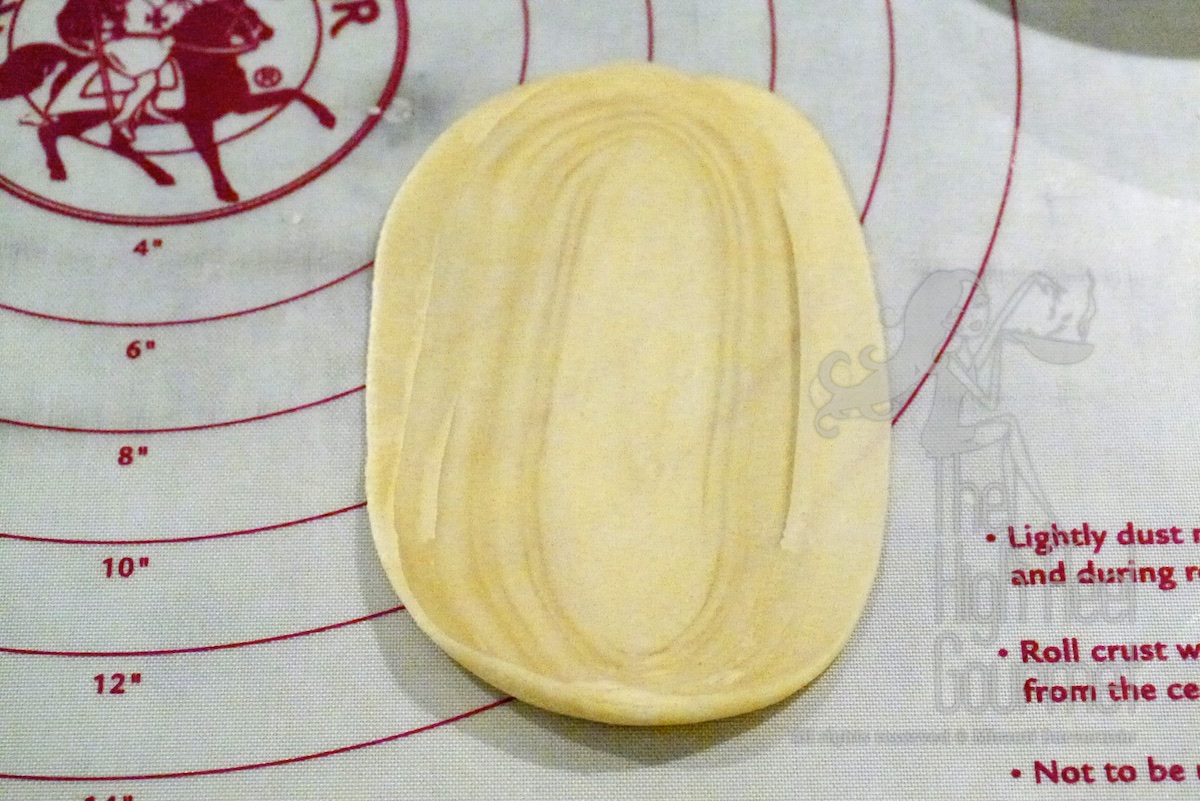
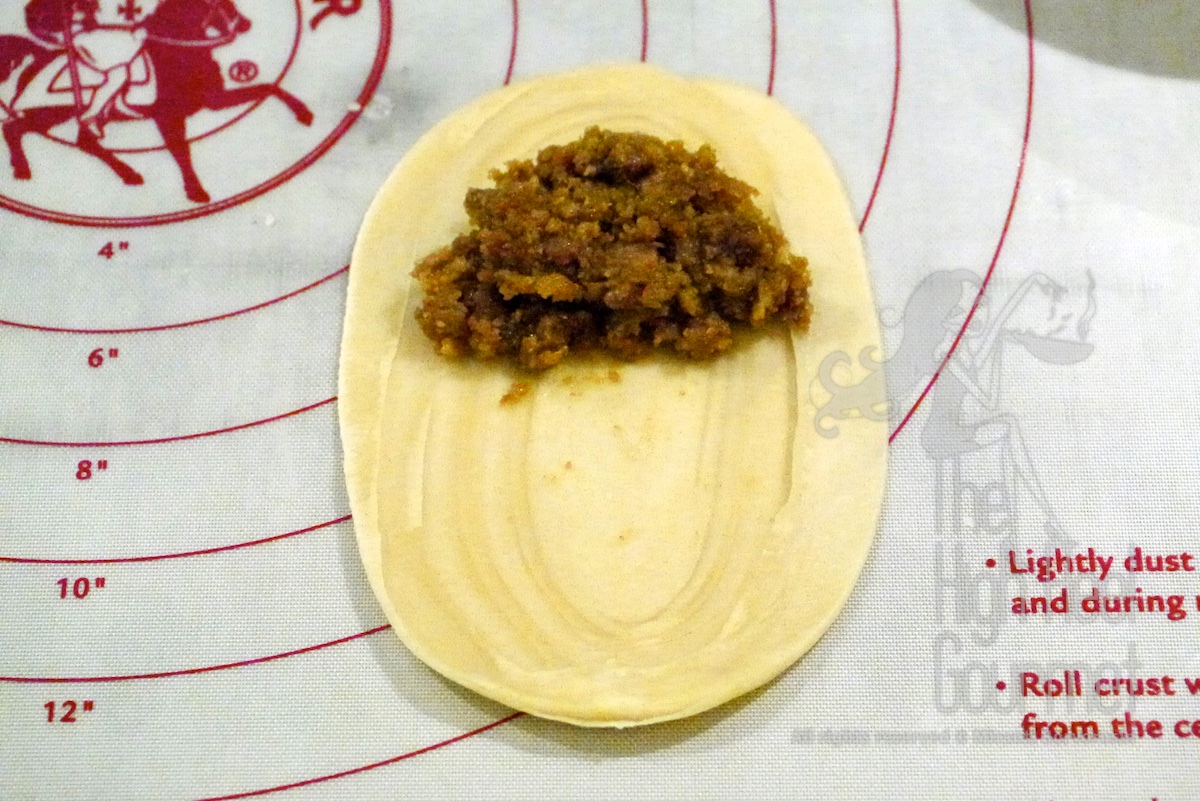
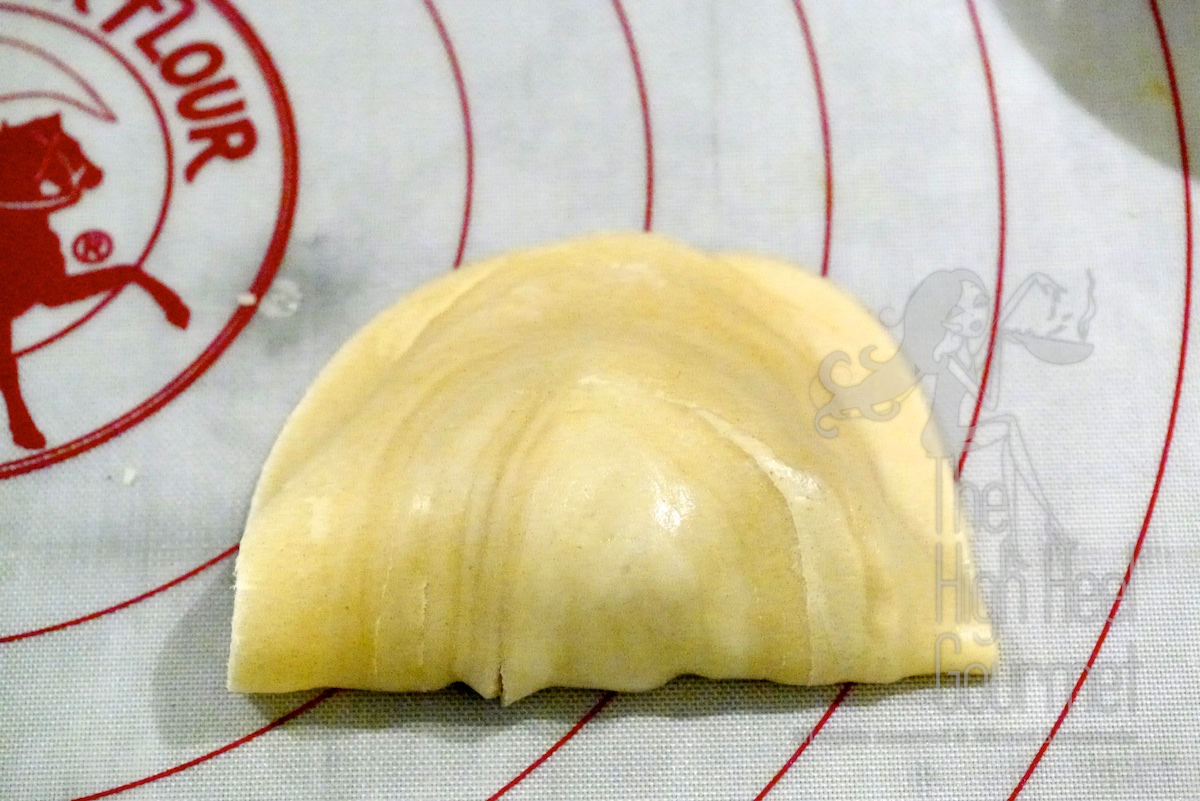
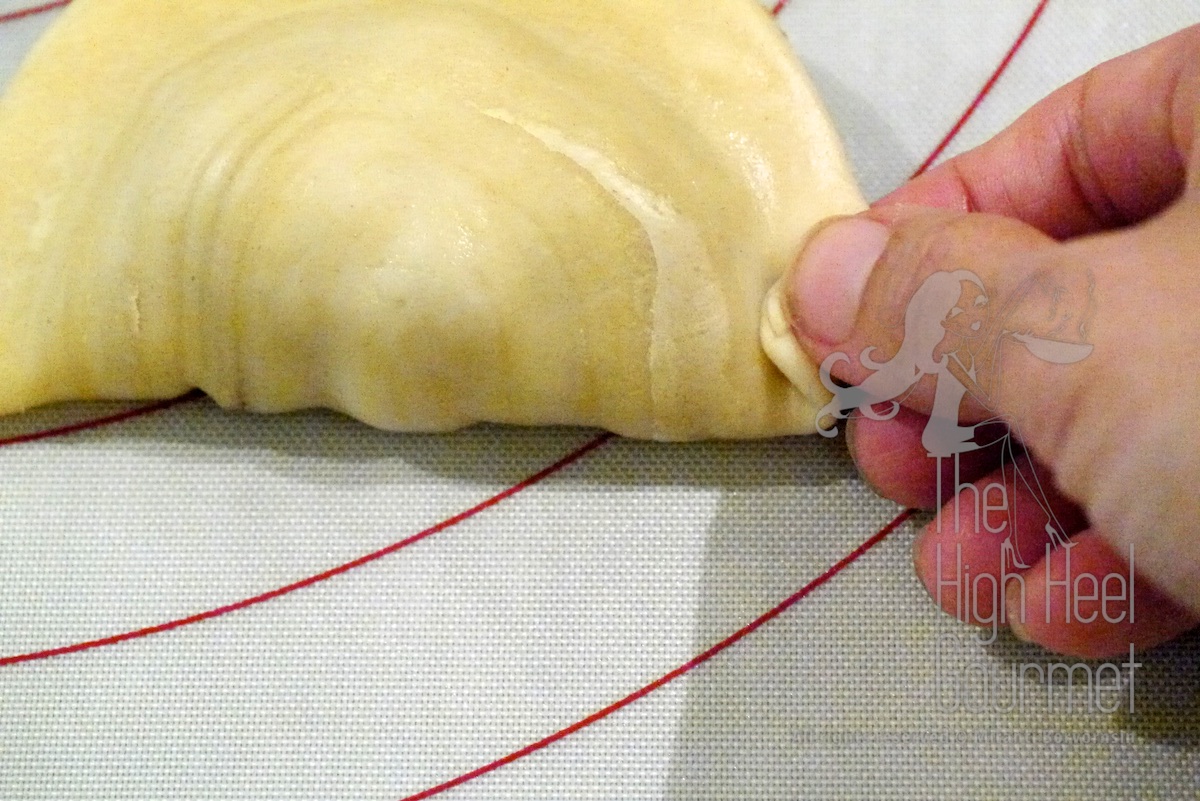
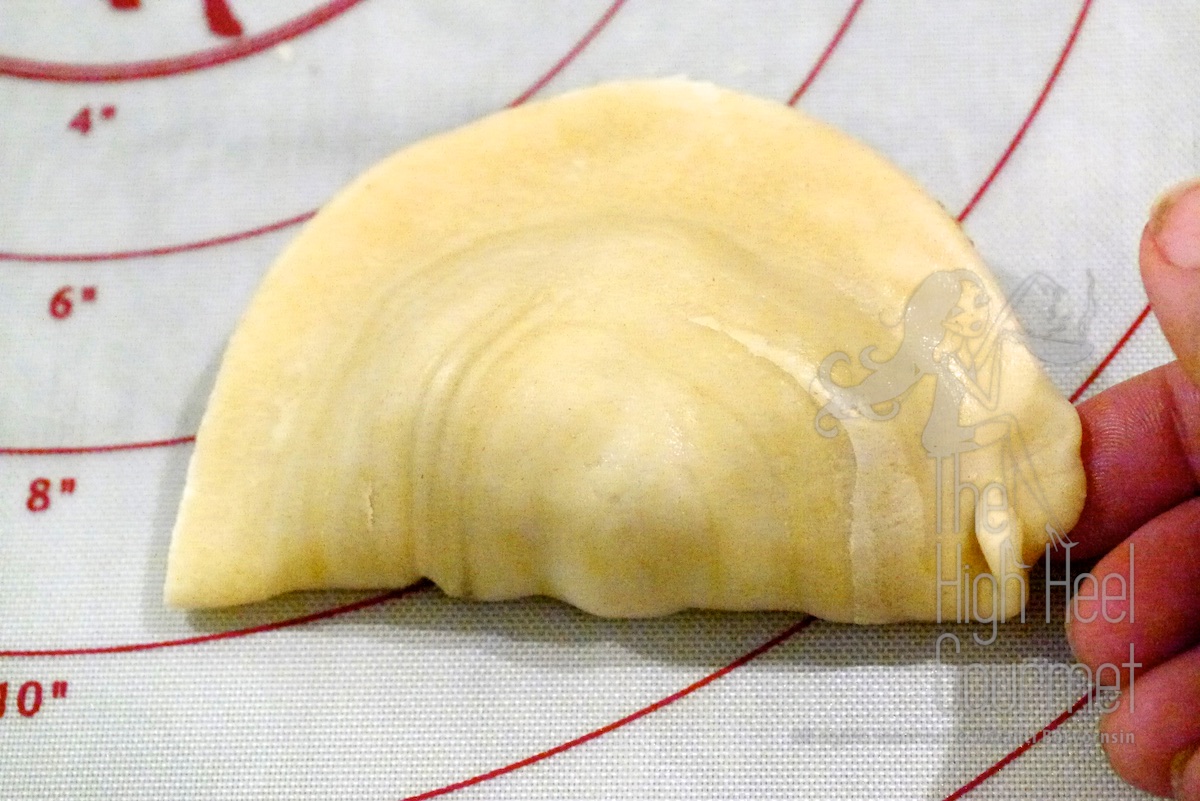
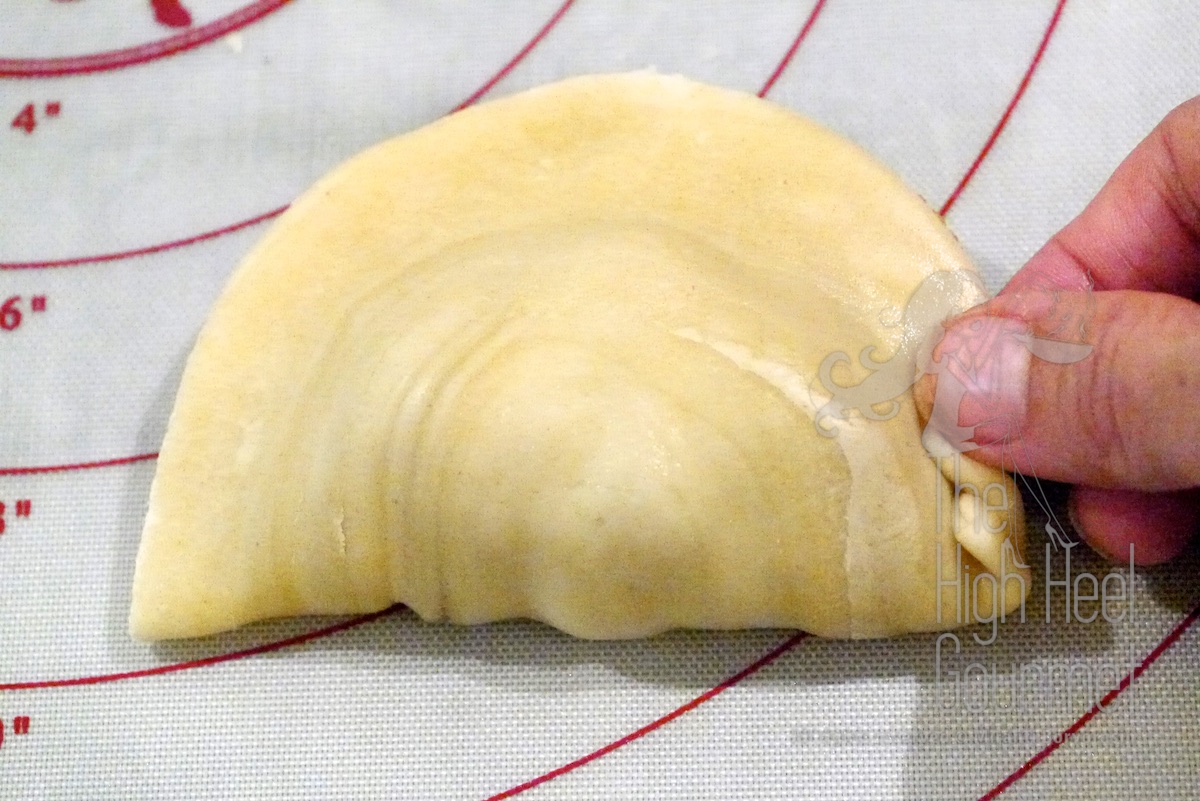
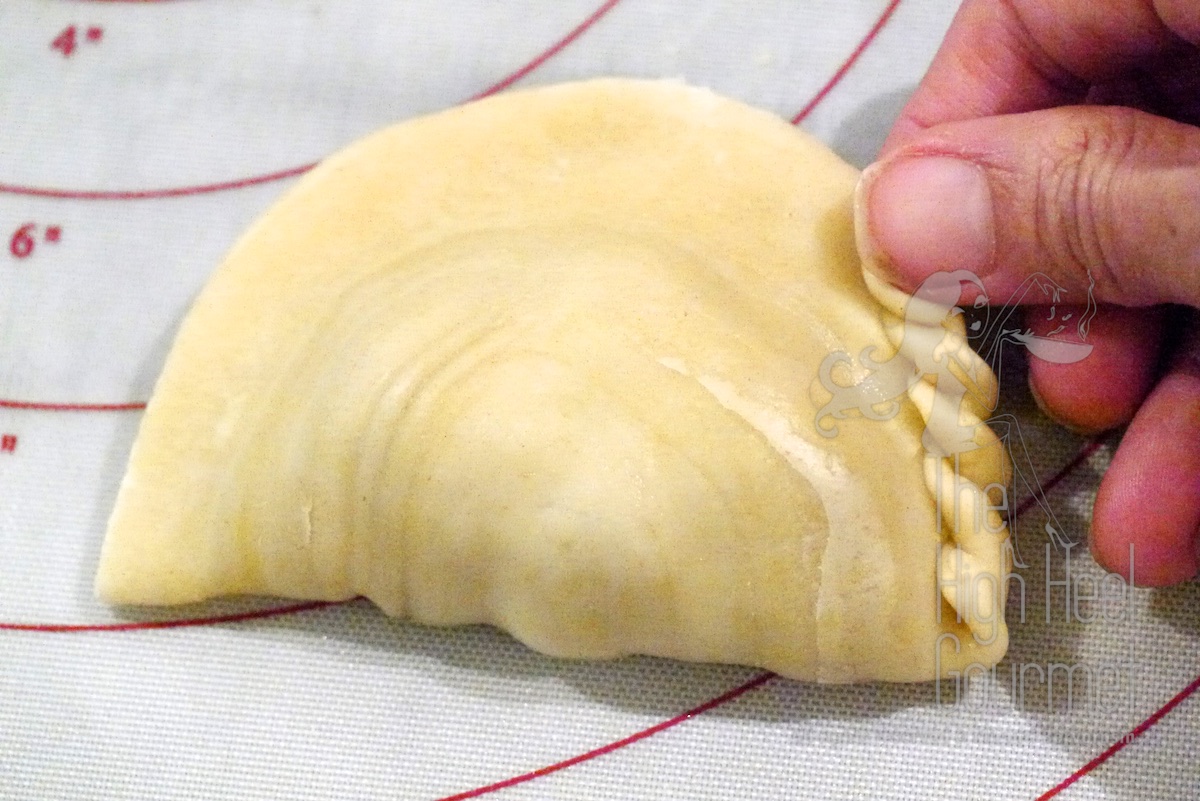
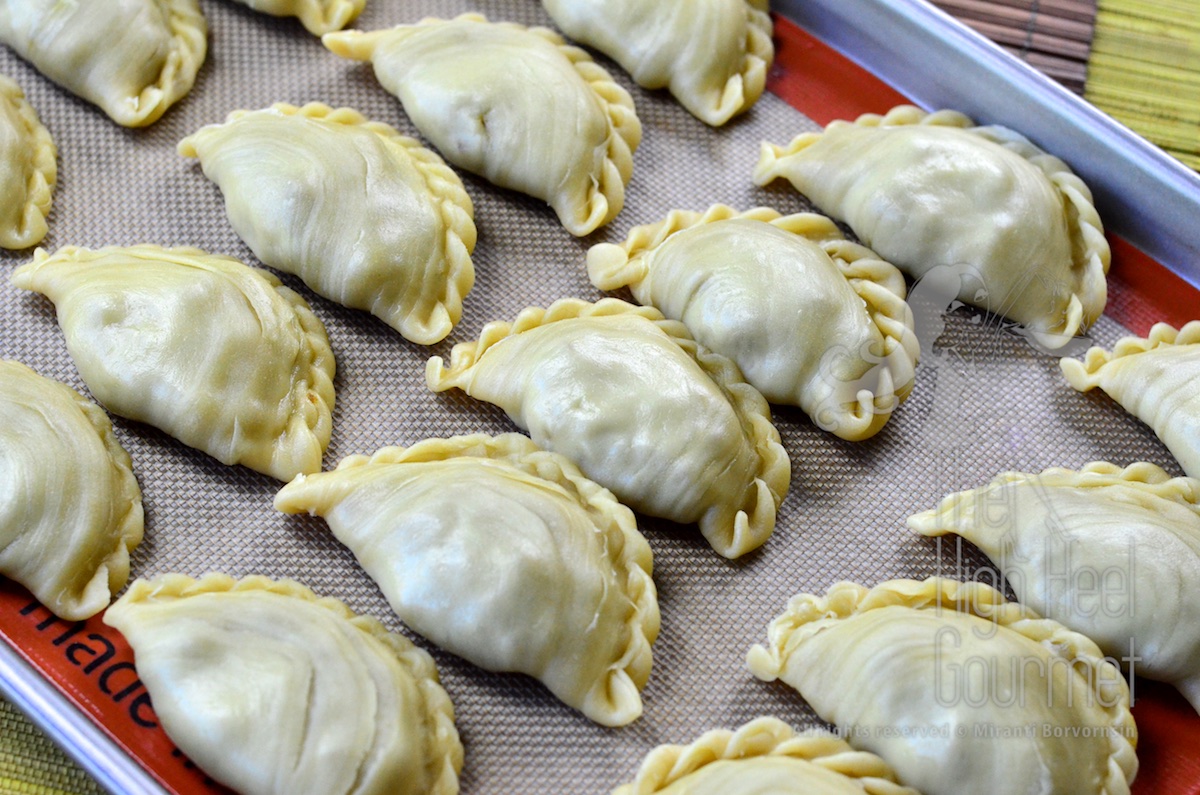
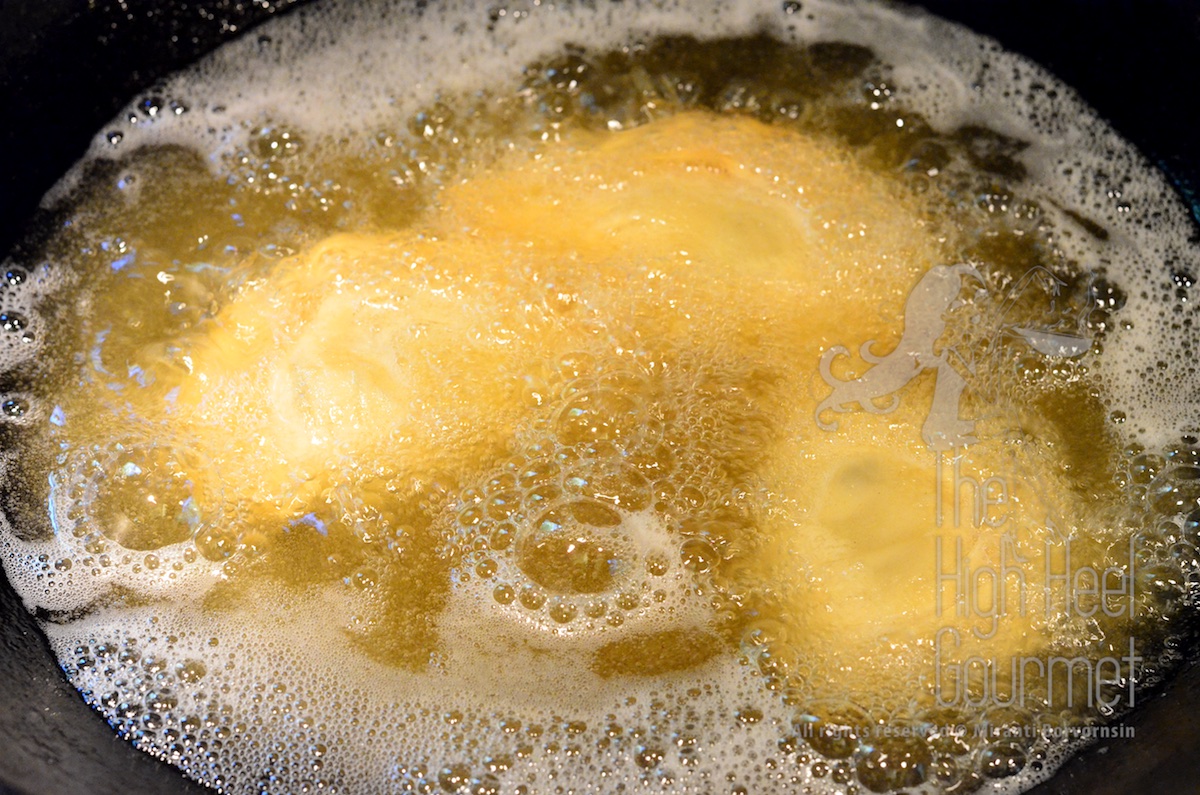
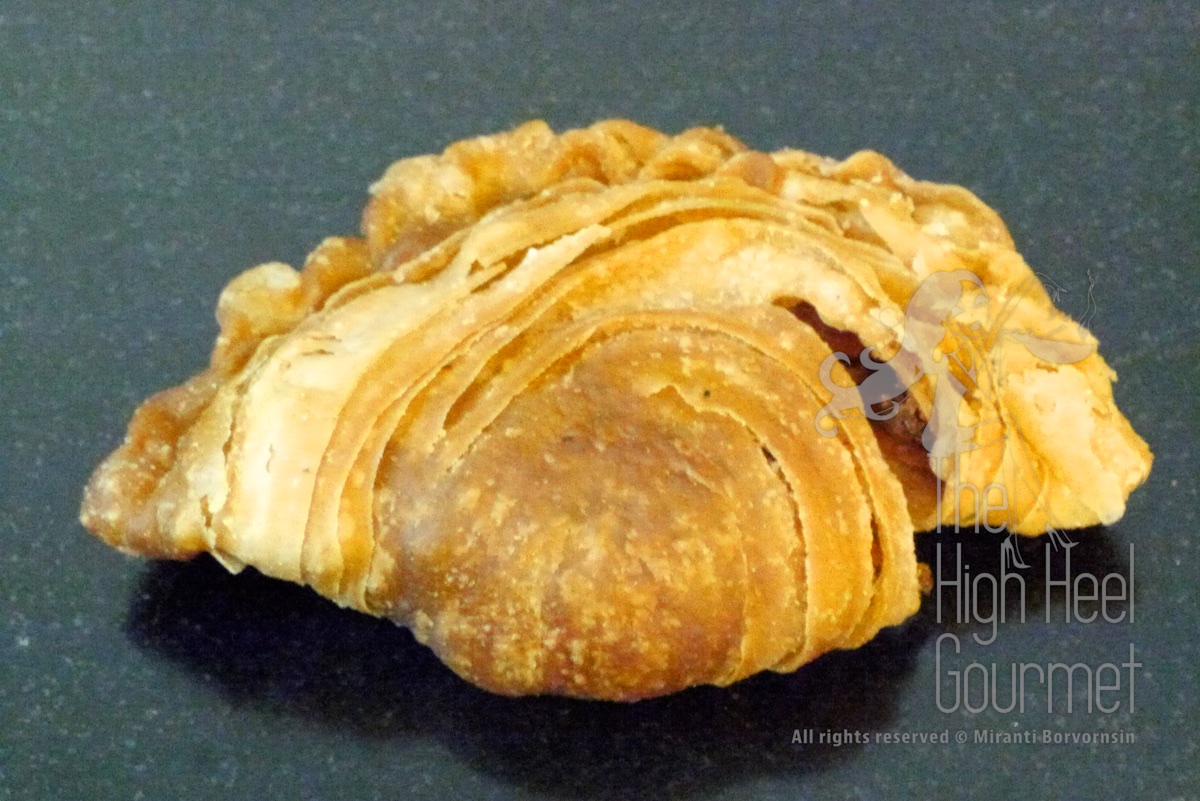
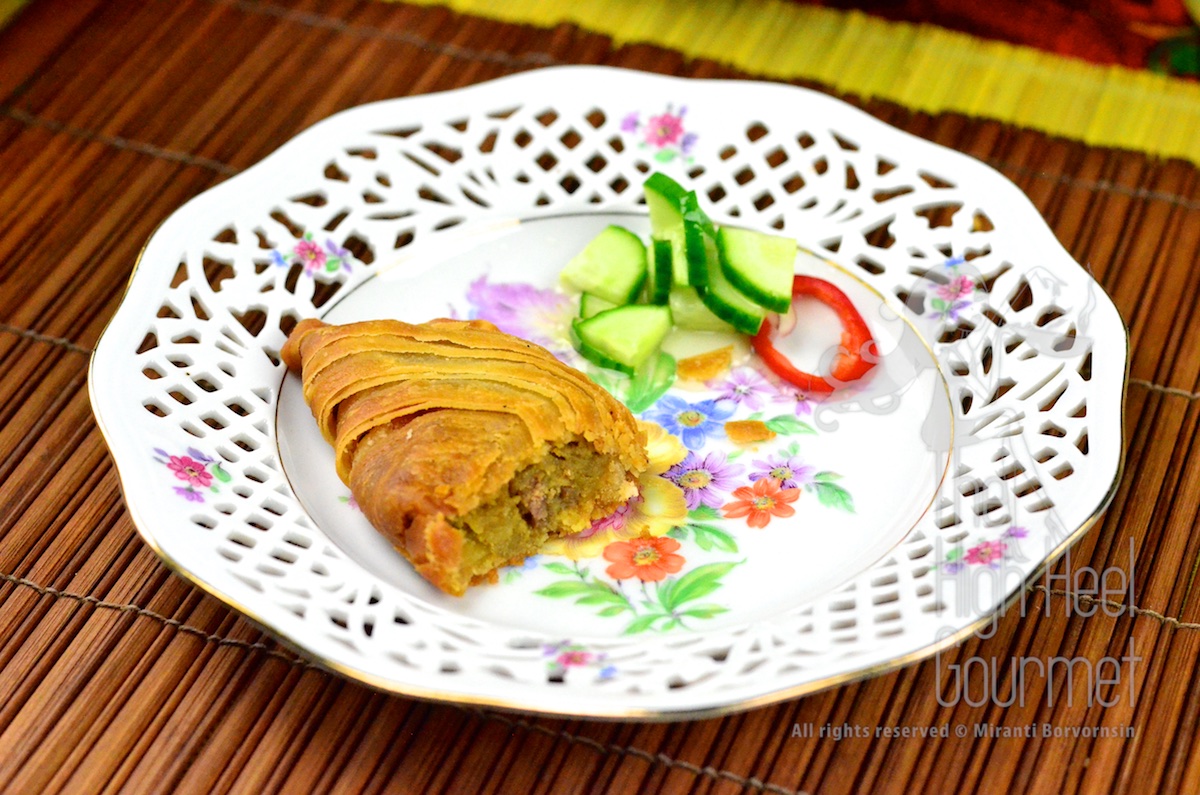
Potato bomb. LOL! I have never seen this dish before. You are quite the chef as always…and a photographer, too. I see you also use King Arthur! The dish really sounds – and looks – great!
I love KA flour, especially the organics one!…Thanks 🙂
Now I know what to buy for flour! Thanks. 🙂
I think I actually hadn’t heard of this. They look so delicious AND like little pieces of art. xx
Thanks 🙂
Miranti,
These are art first, food second. Delicious. I love what you do.
Best,
Conor
Thanks Conor!
They look gorgeously spiced and crisp!
Thanks 🙂
Yummy! This something in between an English dish called wheels and a Spanush and Argentinian dish called empanadas or empanadillas.
Is wheel is the Cornish pastry? I remember I had some in London at a “Cornish bakery” the outside shell wasn’t the circular dough but the filling was nice.
In Malaysia it is called “karipap” too, but depending on the local dialect/ slang it may sound a bit different. In Cantonese it is “Ka lei kok”. In Fujian dialect, ” Ka lee kok”. My kids and I used to love it when Mum came to visit and made these. Sadly she has pretty advanced dementia now; one of the activities that was the first to go was her cooking. Thanks very much for the recipe and the detailed instructions for rolling the dough. Will definitely try this. By the way, it can be made up and frozen, and just fry it right out of the freezer. Some do this with a sweet stuffing eg red bean or lotus seed paste but curry is the best!
Thanks so much for the info! I don’t remember the exact words but I know karipap isn’t really the way they call it in Chinese. In Singapore is another word I think close to Ka lei kok but I will find out in September when I visit Singapore.
Also Thanks for the suggestion about freezing. Next time I will freeze some and see how the dough would do.
Do you know the spicy one with the hard boiled egg they sell in Singapore? My friend show me the picture that they made the red bean as an outside shell for the spicy beef and cheese inside so, you thought it is sweet but it is actually not. I want to try that one.
I hope your next batch is getting better. I’m not getting the “perfect” dough yet either but you would know it as soon as I found one.
I’m so impressed with the layers of the dough. Will definitely put this on my “to try very soon” list! Thanks for sharing, and giving such detailed explanations and photos. :0
Thanks. Let me know when you make them. I’m still trying several recipes myself too.
Reblogged this on The ObamaCrat™.
Thanks 🙂
😎
oh, oh, omg! A definite on my list. Delicate looking with a tasty filling. I love a challenge. . . have successfully made puff pastry from scratch, so I look forward to making this recipe.
Gina
Let me know how it goes. I’m still trying to find the “perfect” dough myself.
that’s it, this does it – we want to be guests at your home for dinner, lunch, brunch – all of the above!!
Ok you will have to make coffee then 😉
It’s a deal 😉
Fantastic and delicious recipe.Regards.
Thanks
Wow that looks incredible! I love how fancy the dough looks. I just sent this recipe to my brother who is in culinary school in Bangkok. I think he’d love this recipe!
Great! He might already have some over there too!
LOVE this recipe!!
🙂
These look amazing! I want to eat them right now
🙂 You might have to start from making the filling. My friend use the filling to make sandwiches!
Love the teacup!
I got it from Amazon!
Have never seen these before, like a savory version of Italian sfogliatelle!
I have to look up what is the “sfogliatelle”! I never heard of it before.
Indian/Asian markets have this in the freezer section called paratha. It has plain, onion, leeks, etc. 4-5 sheets like a tortilla (already spiraled and rolled flat with parchment paper between each frozen slice). I use it for that chinese beef roll with hoisin sauce. You can cook in a pan about a minute and half per side, or in this case, just let it thaw and then make puff filling!
That is not the same dough. Paratha do not have the same type of layer as this circular dough.
They normally have egg is the dough as well. The way they make layers, is (this will discourage you to eat them lol) soak them in oil, stretch the dough out thinly on the surface covered with oil or ghee, then fold. The oil that covered the dough will serve as the layer separator and they fry the dough in oil or ghee to cook them. I love paratha. They call it Roti in Thailand and I make them from scratch often to eat them with curry.
I followed the recipe and the oil dough was not as sticky as I had anticipated. Got a bit better with extra oil. When I rolled out the combined dough, spiral were there but soon became separated. Not sure how else I could have done them. I managed abt 15 pieces but abt half fell apart in the oil. Please advise, much appreciated.
How many roll did you do? I did three and I just did two yesterday. I think you might have to start with less layer by doing more roll but each roll smaller. With this recipe you can make up to 15 rolls. Then cut each roll in half. The less layer is easier to fold and close. I wish I can set up my Go Pro right next time do you might have some video.
The layers are quite delicate. You have to handle a little more careful. You can use the spatula to help keeping them together.
Another thing is in the beginning you can roll then a little thicker too. I remember when I started rolling and wrapping, my karipap weren’t so popular because the dough were thick but I got fancier and fancier over time.
Do you want to send me some picture? Highheelgourmet@gmail.com or just posted on my Facebook page. If I are it I can tell more.
Sometime the oil dough that isn’t cohesive would destroy the whole structure too. I usually make sure that I put enough oil in the oil dough. If you can roll a ball about 2″x2″ without crack, that’s the right dough that would help holding the layers. Don’t worry about the oil dough with too much oil. This part would fall in the hot oil when you fry anyway.
Sorry I’m all over the place. I’m not quite sure what’s cause the problem so I’m guessing all the possibility.
I think you probably have too dry oil dough but I’m not sure unless I see them. Do you want to try with more oil in the oil dough?
Falling apart when frying is only two possibilities, oil not hot enough and also too dry oil dough, the oil dough falls in oil before the rest harden and set.
Thanks for all the suggestions! I will soldier on! Regardless, my son ate most of them for dinner and claimed that the dough is really nice!
Good…now you are ready for round two. I’m envy…my dog sort of turn away from these now 🙁 I guess Thai dog don’t like curry!
Looks amazing! The layered pastry is beautifully done! Kudos!
Reblogged this on This Got My Attention and commented:
OMG, these look soooooooooo delicious!
The pufs look so pretty with the rolls and layers.
Can I bake them instead of frying?
You can but the dough will not be as crispy.
I baked them at 350 degrees. The result was excellent. It’s healthier and no mess.
Hi, I try your recipe for dough just now. The pastry layer fall apart when I rolled them out to put the filling! Why? My doughs are dry even I put in more oil and water than you suggested. How moist should the doughs be?
The outside dough should be wet enough to form a ball and stretchy enough to roll. I would say about the same as pie dough. The inside dough since it’s an oil dough, it won’t be “stretchy” because the gluten will not form but the same wetness.
What’s kind of flour are you using? Did you rest the dough?
Hi there, I found you when I’m looking for authentic Rad Na dish, and glad that I found it here. Your karipap as we say it in Malay look delish. Karipap in Malay usually, a pastry that filled with savory filling and seasoned with curry. As to my limited knowledege; epok-epok usually a pastry that filled with sauteed vegetable and egg. Along the coastal of peninsular you can found epok-epok with fish filling or tembosa in Terengganu and Kelantan dialect; surely they are not using the spiral dough like the one you made. One interesting fact that in East Malaysia, there’s, karipap that filled with fired mee or fried rice vermicelli. and yes this two type of epok-epok should be eaten with special cili sauce. As of the history of this dish, like you after months of research and internet surfing I gave up and surrender. one thing for sure, karipap will always be my favorite and yours were truly amazing and too good to be eaten… take care and keep posting good food. Cheers from Malaysia
Thanks for this info! I really appreciate it very much. I ate many many kinds of epok-epok and I can’t seem to fathom the variety of them or get a grasp of a true history. Each family has their own version. I had one with fried chicken stir fired with peanuts and spice but instead of using potato inside, they use taro! Sky is the limit on these and most of them that I ate, use circular dough.